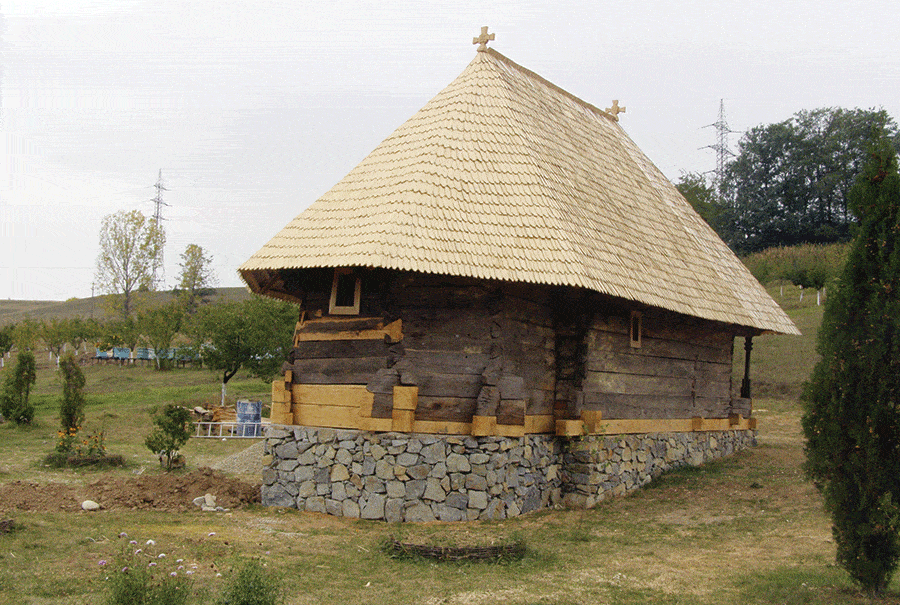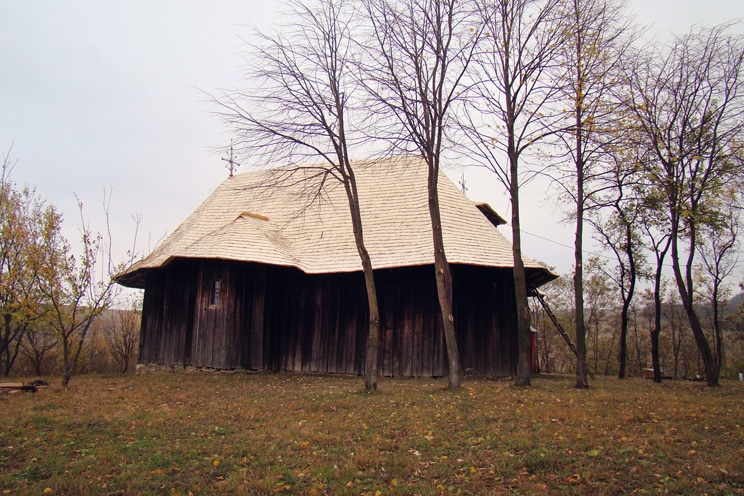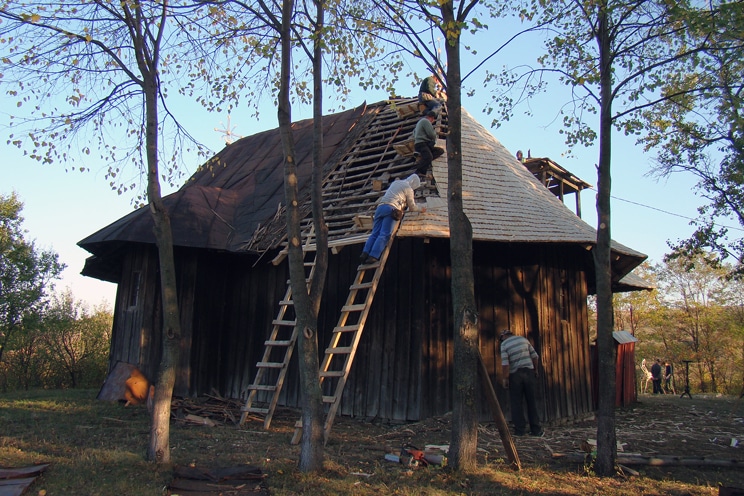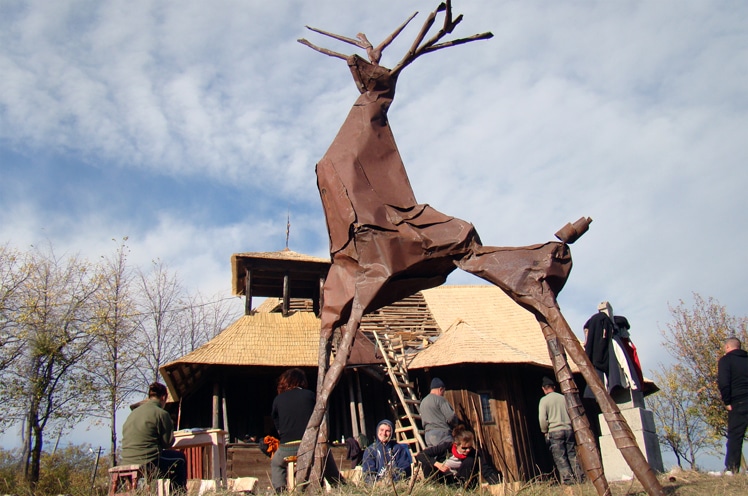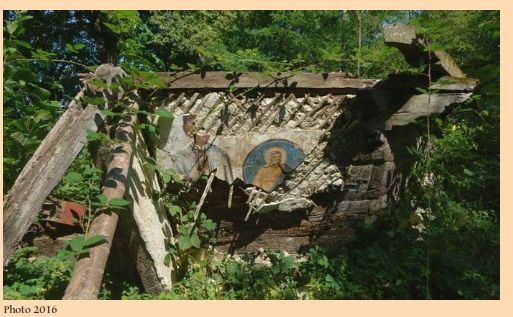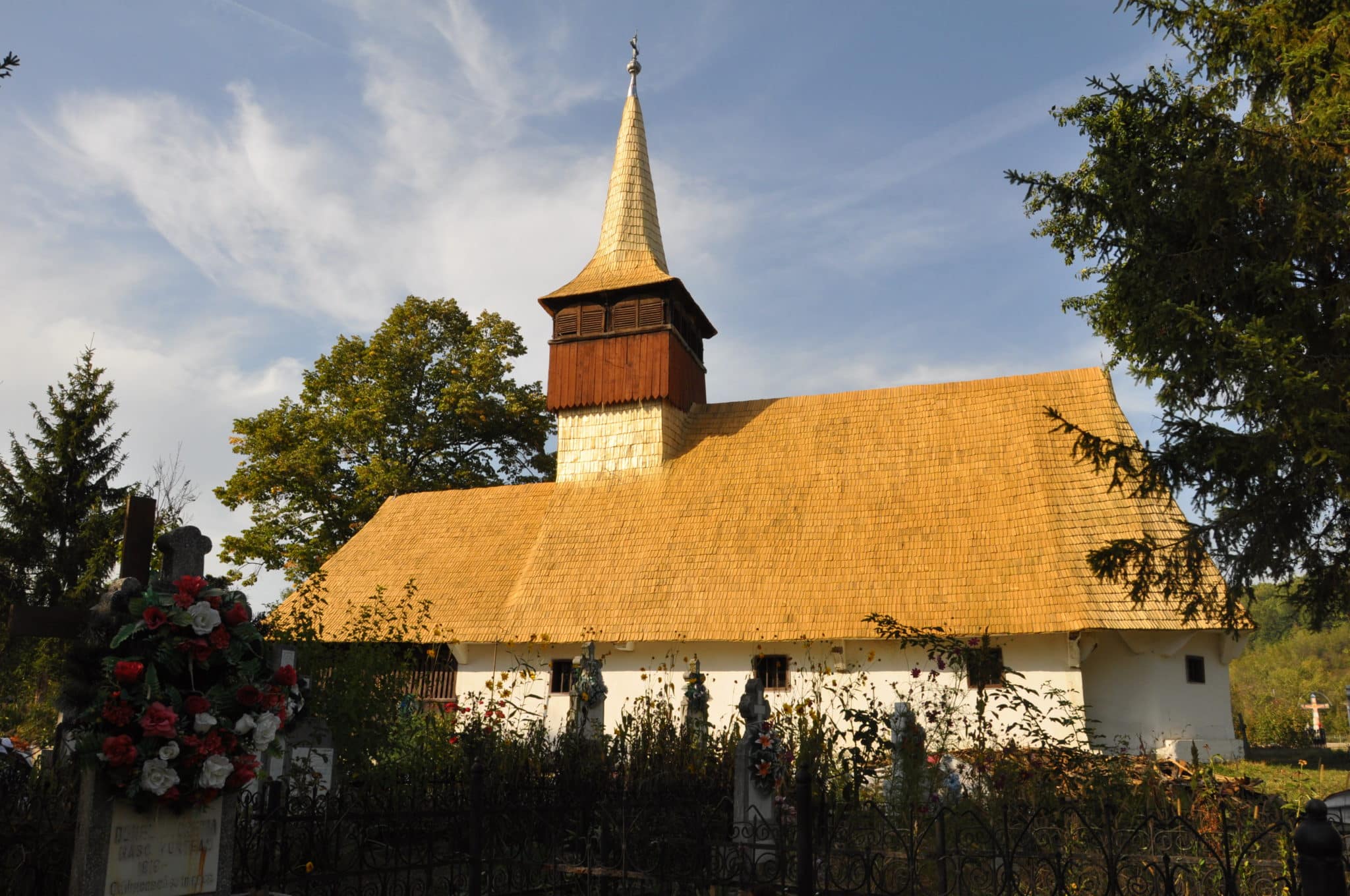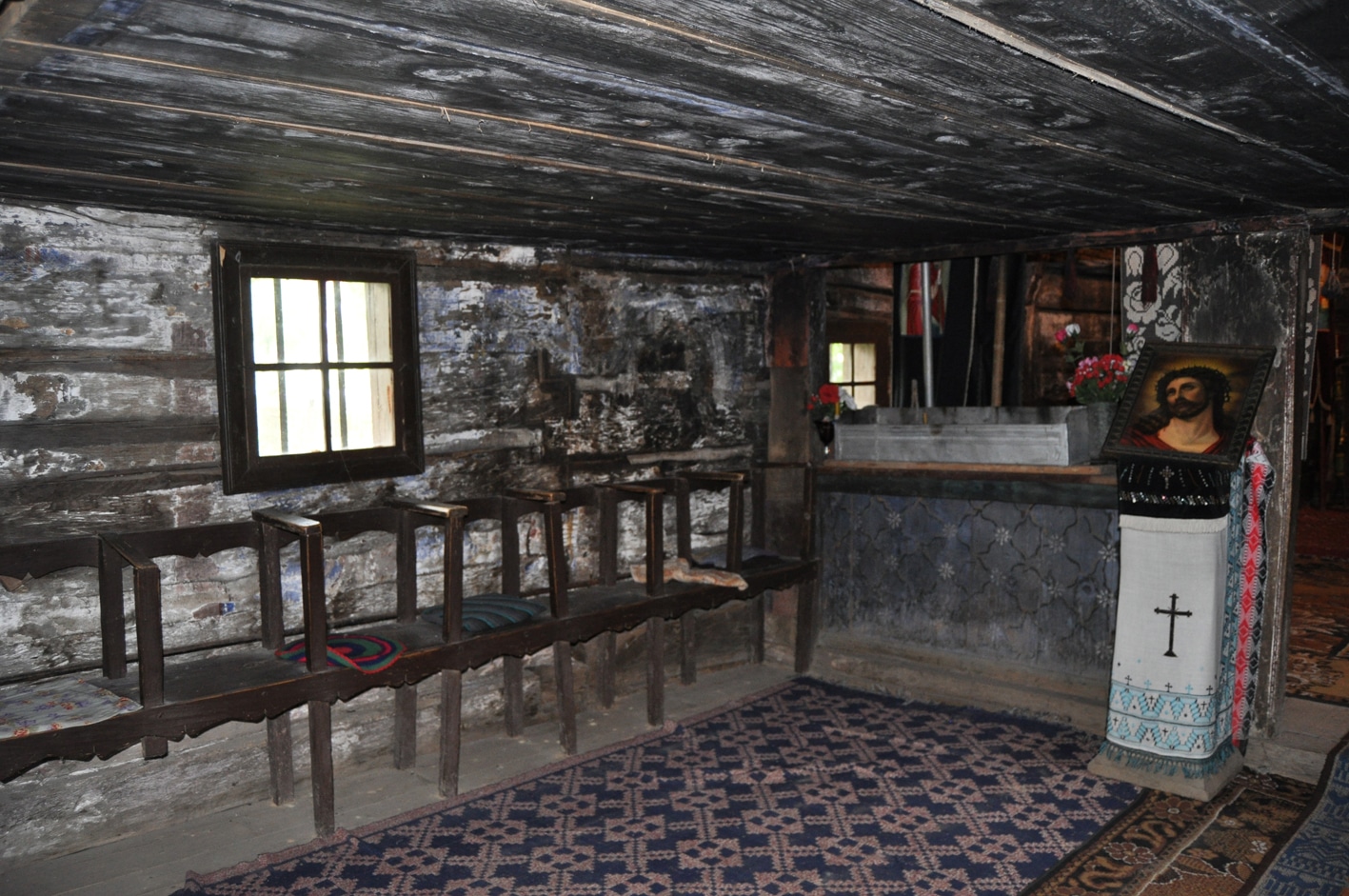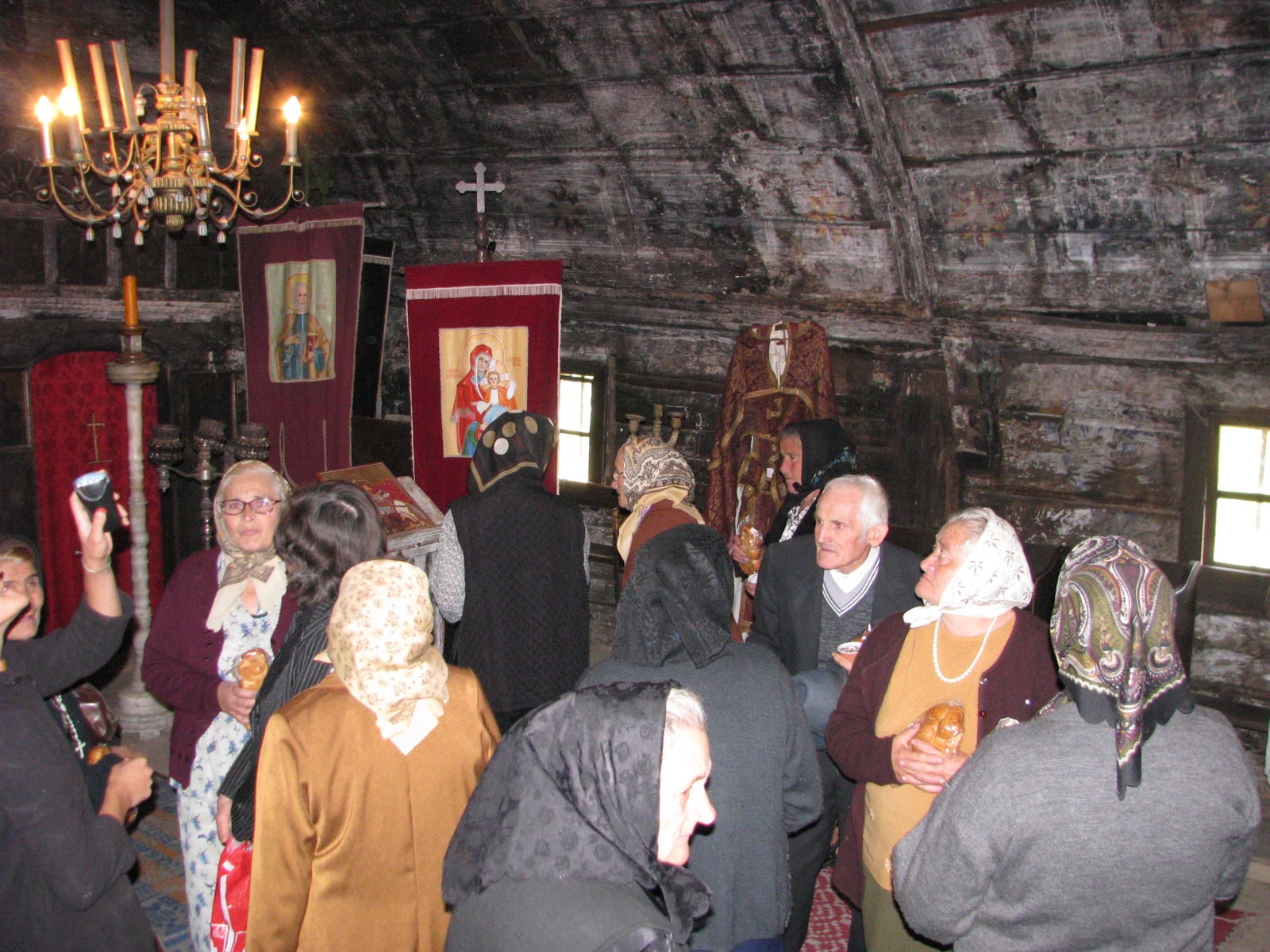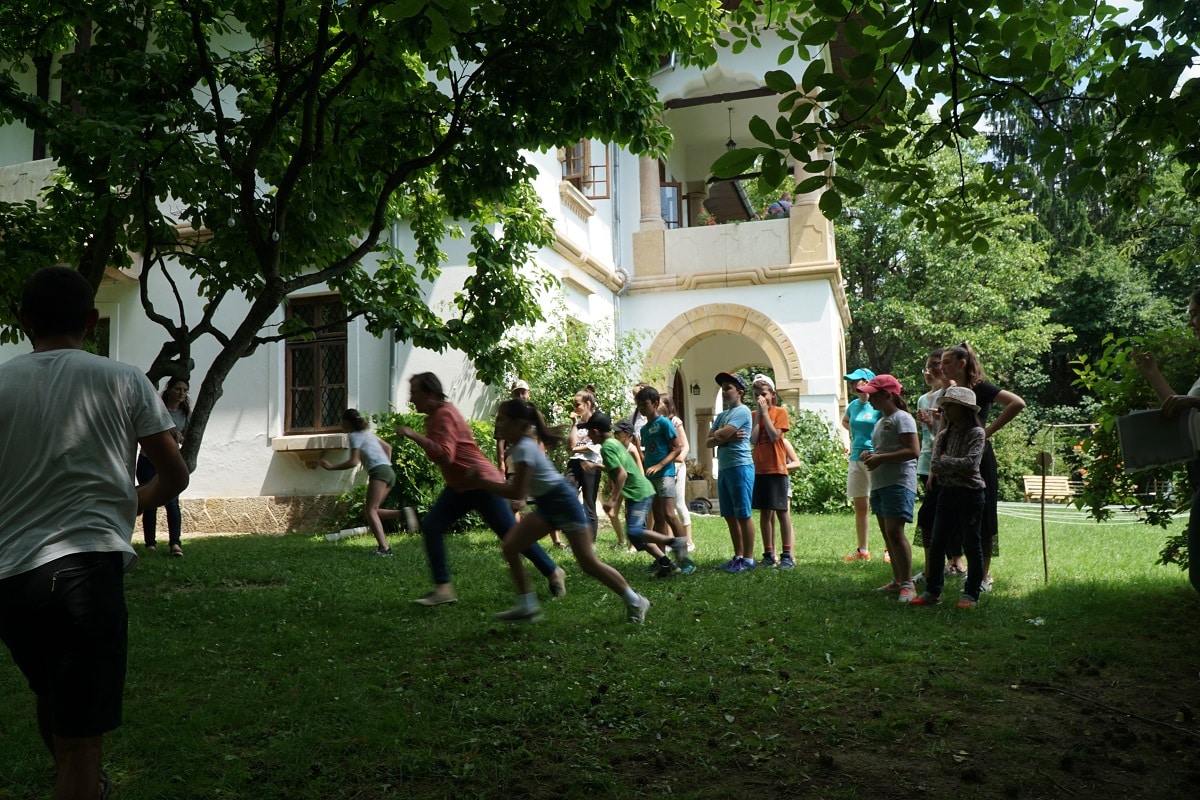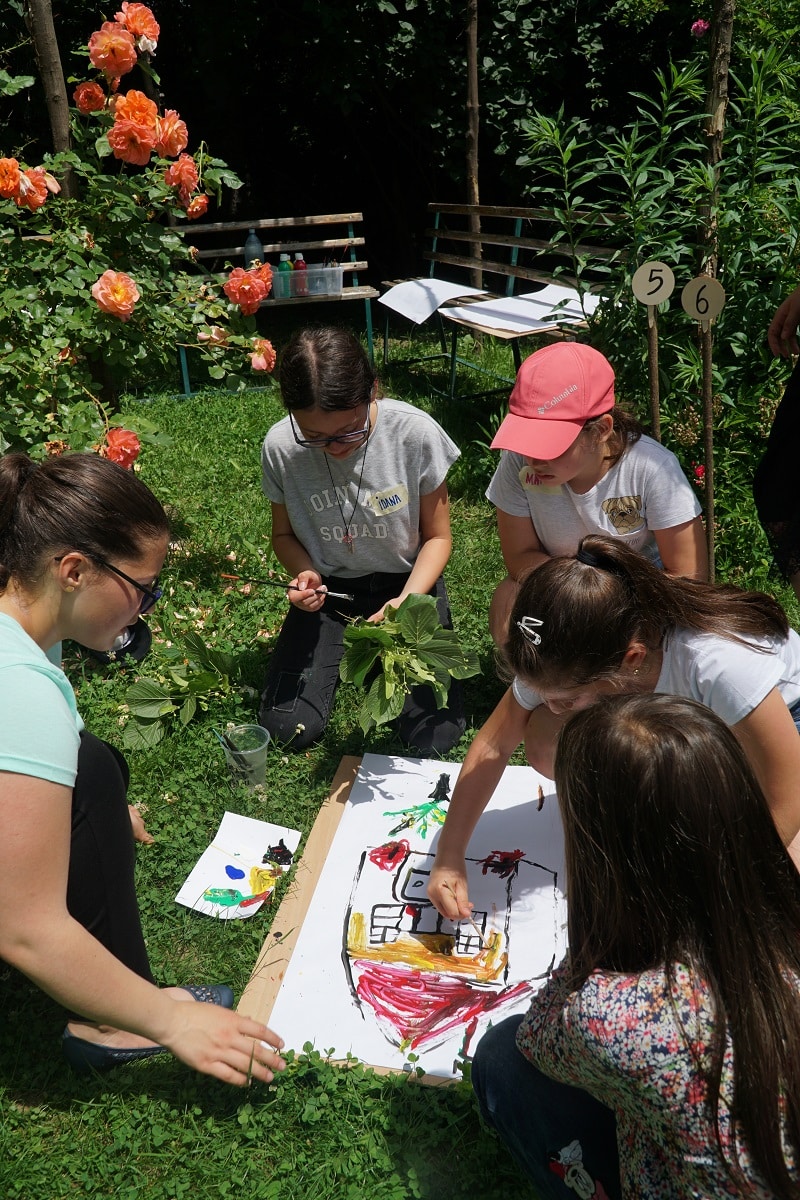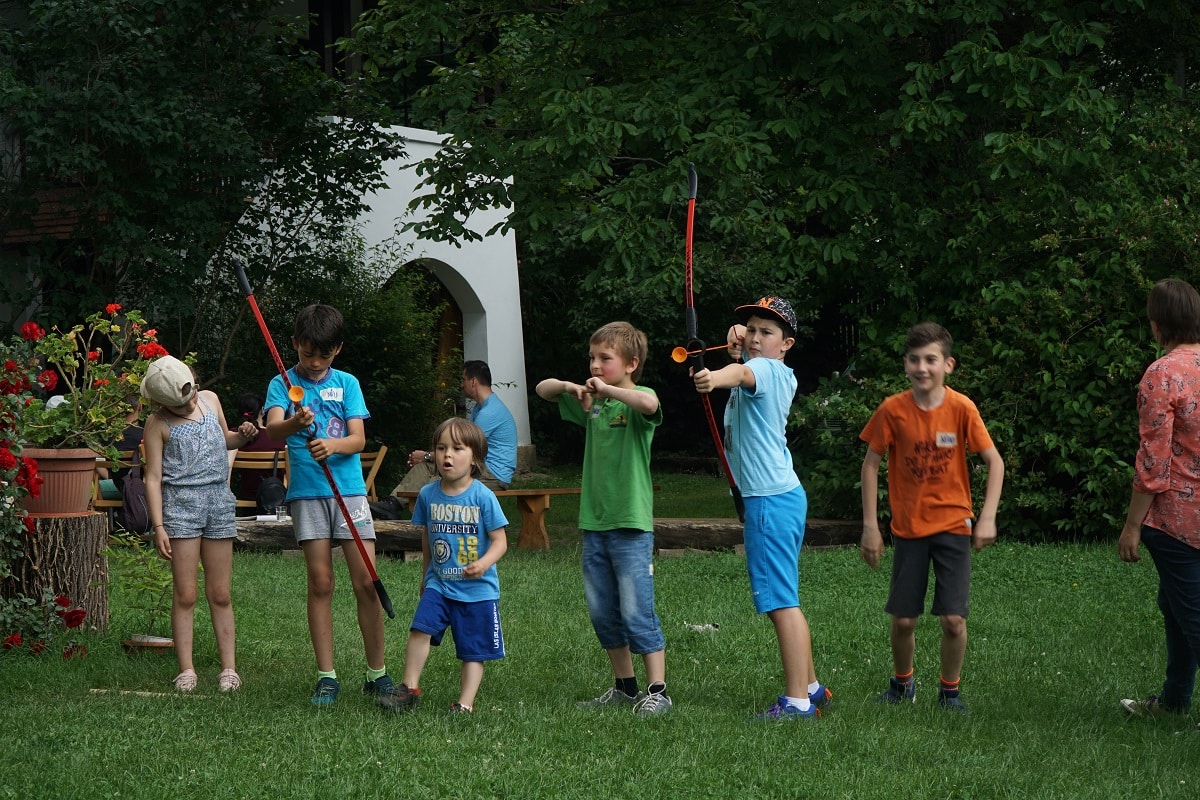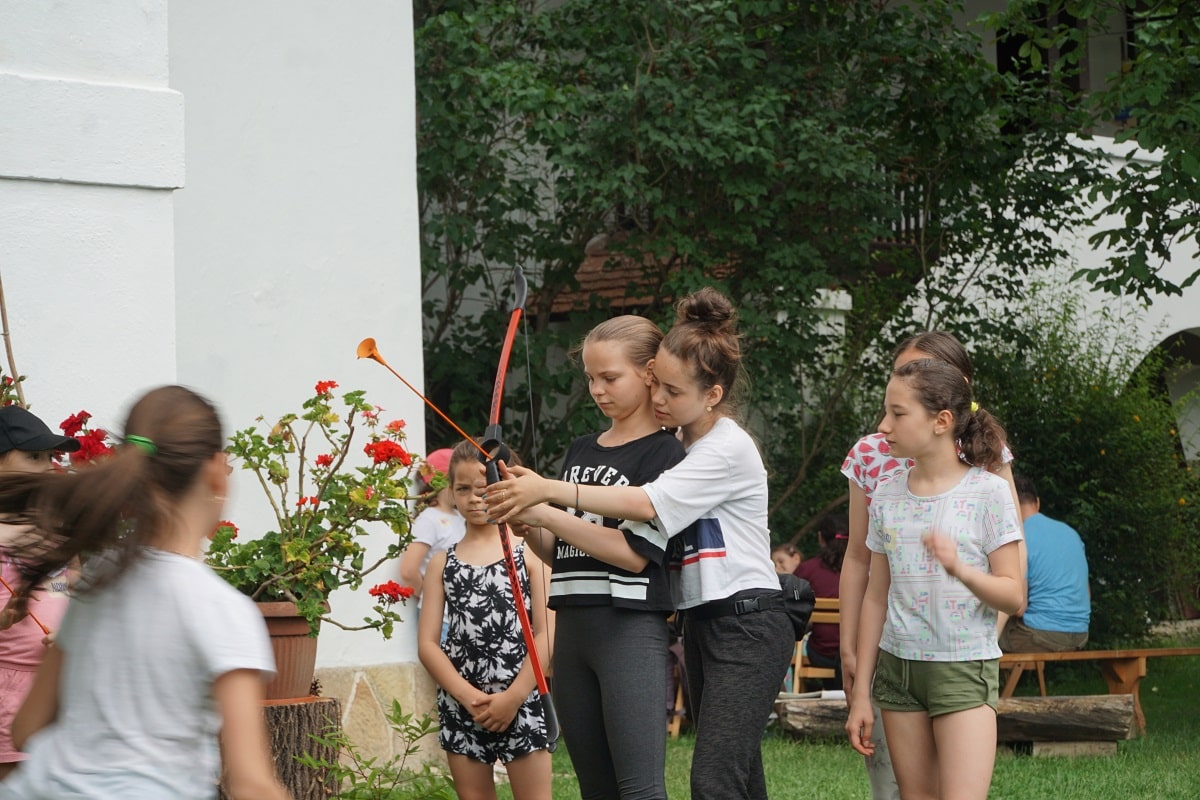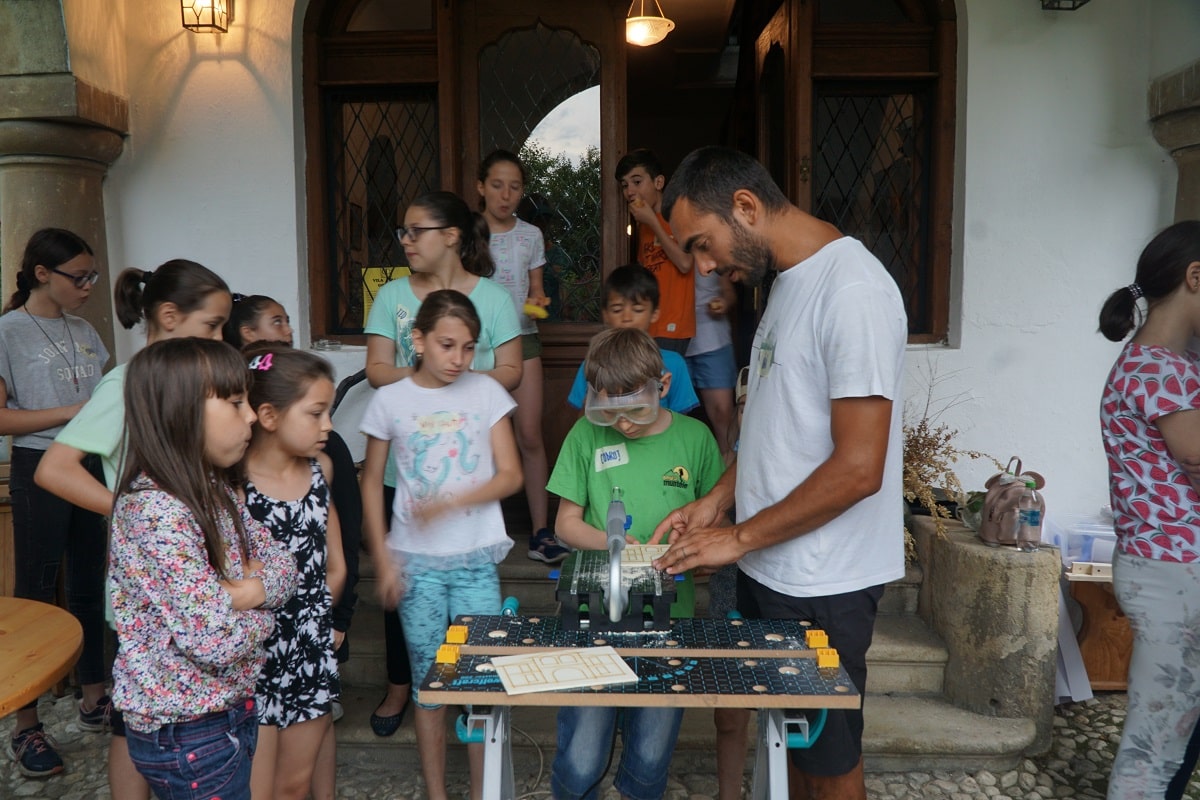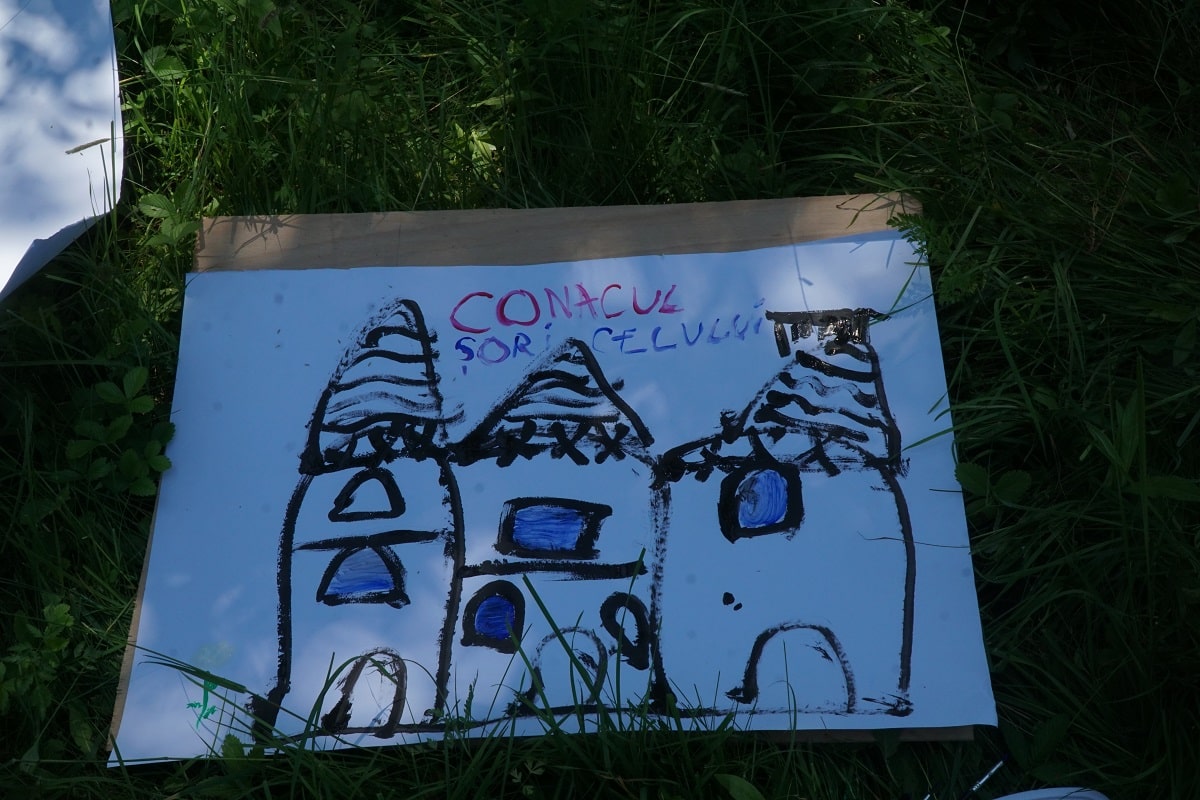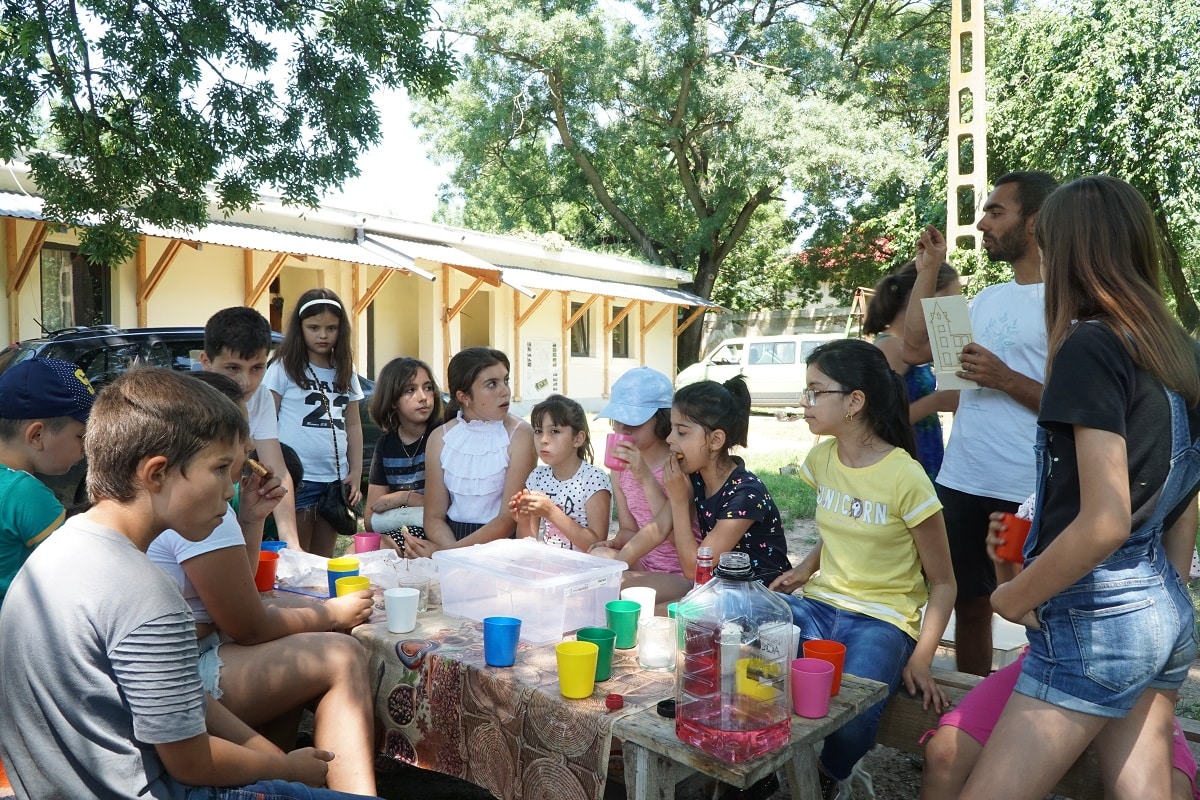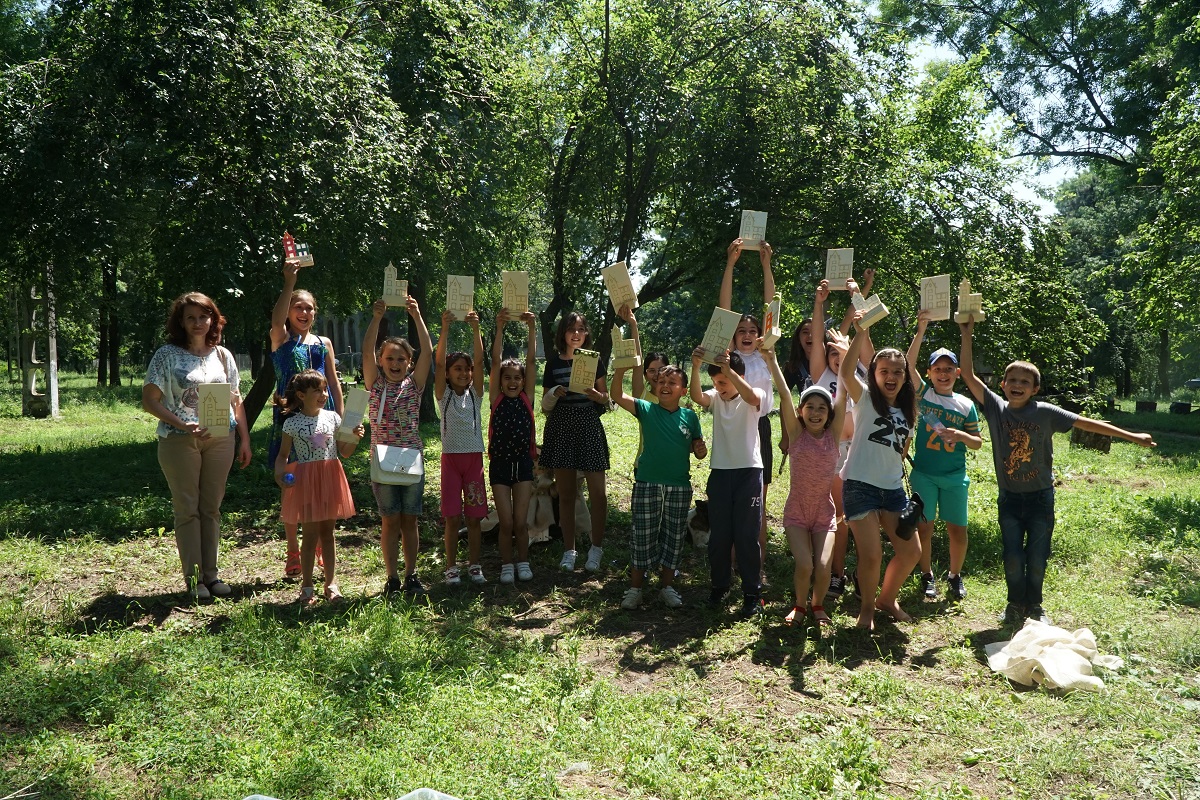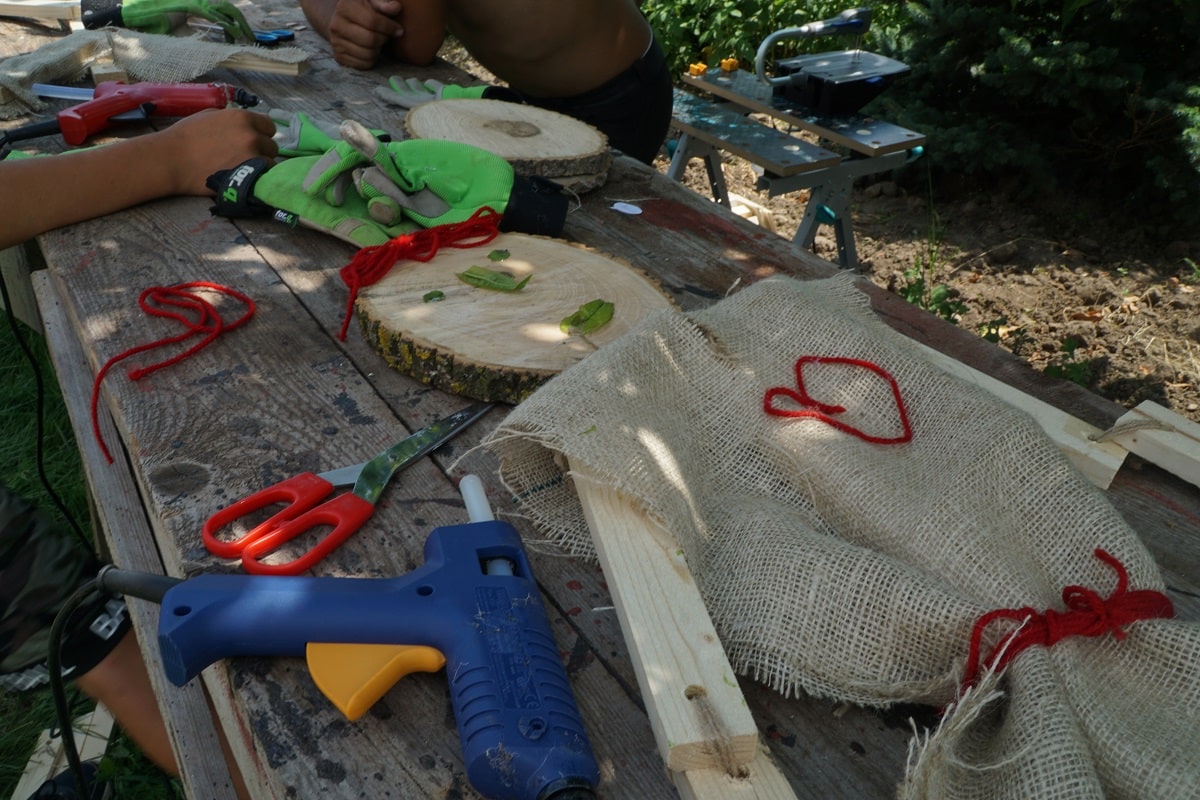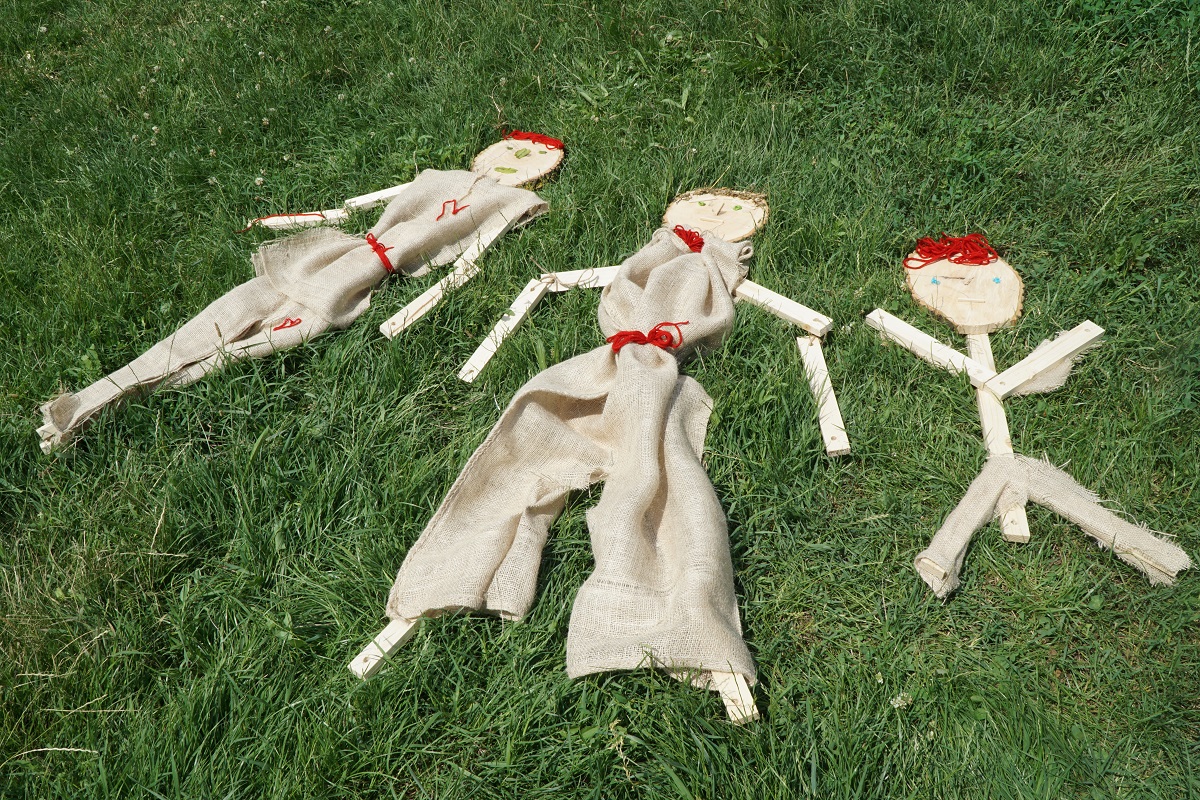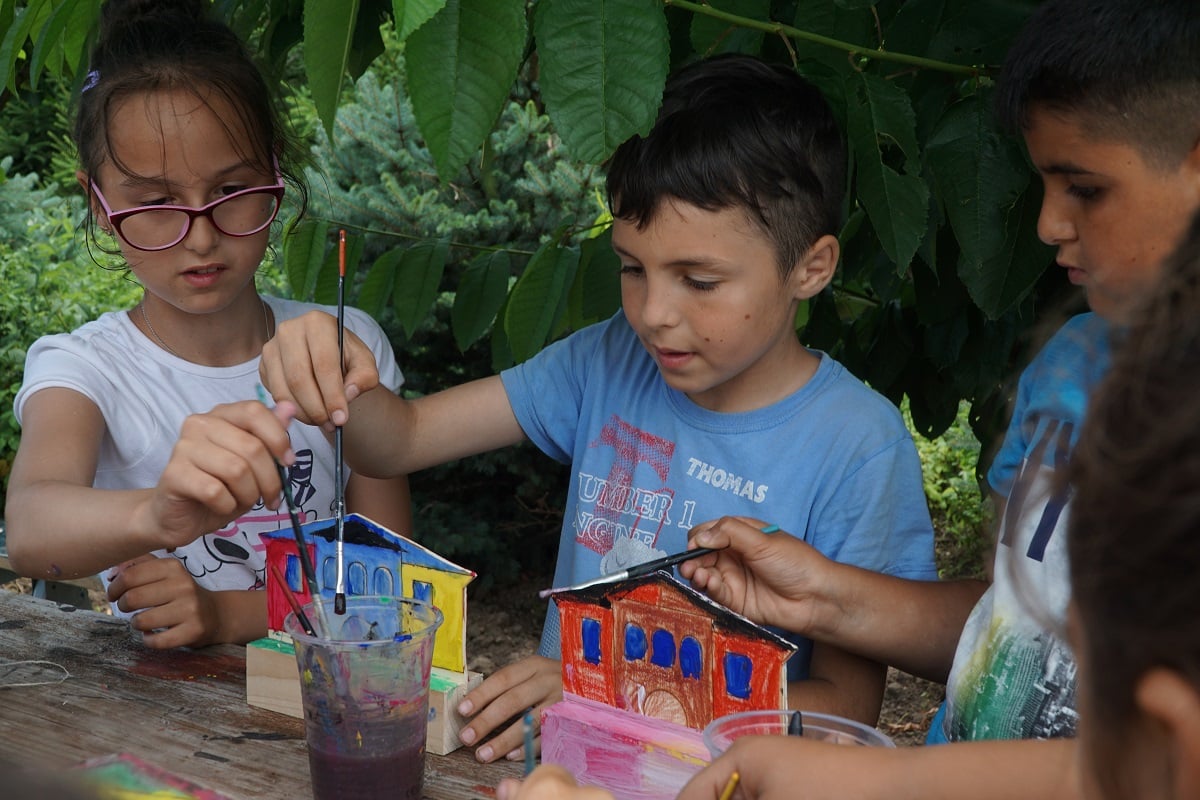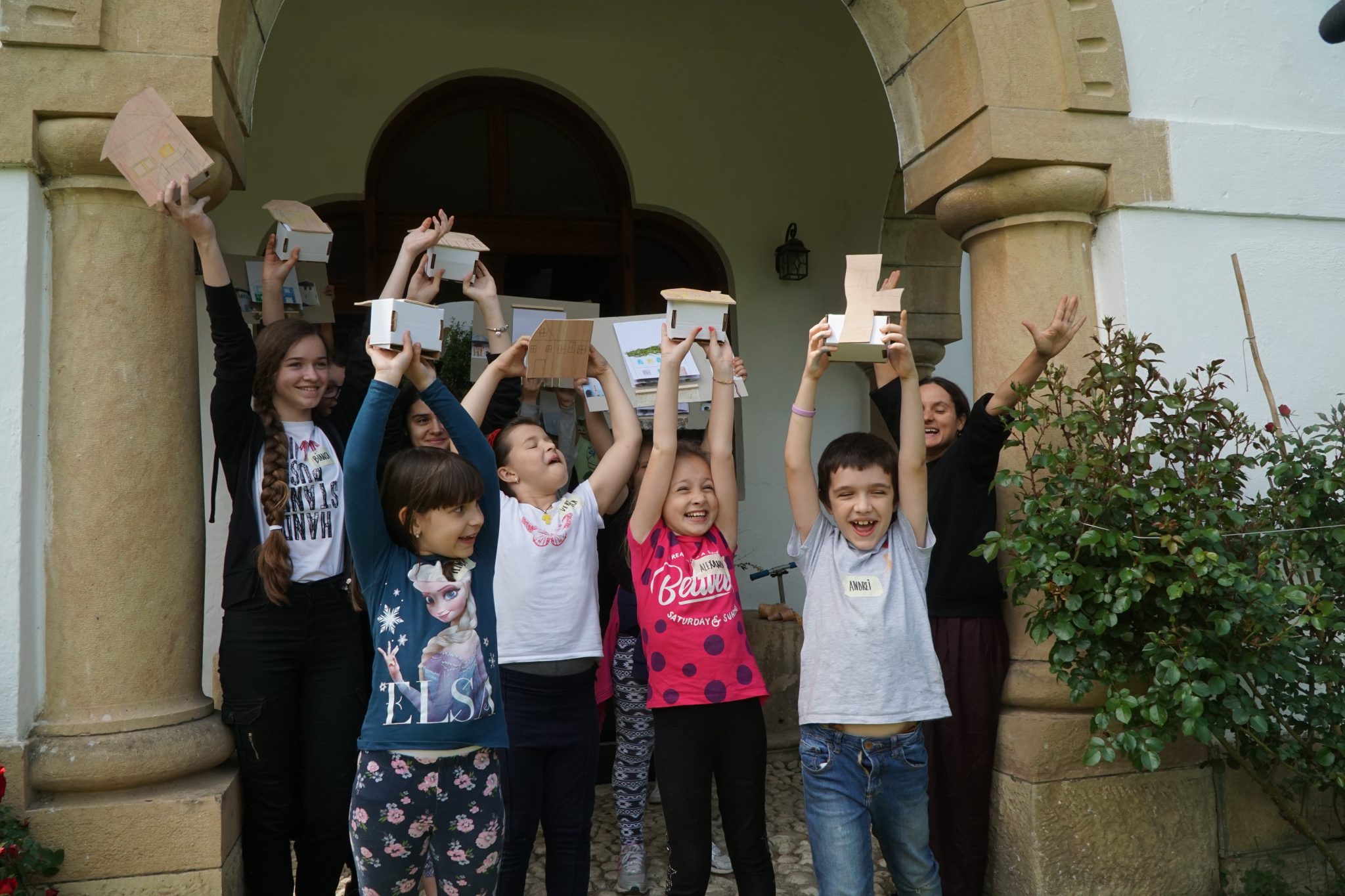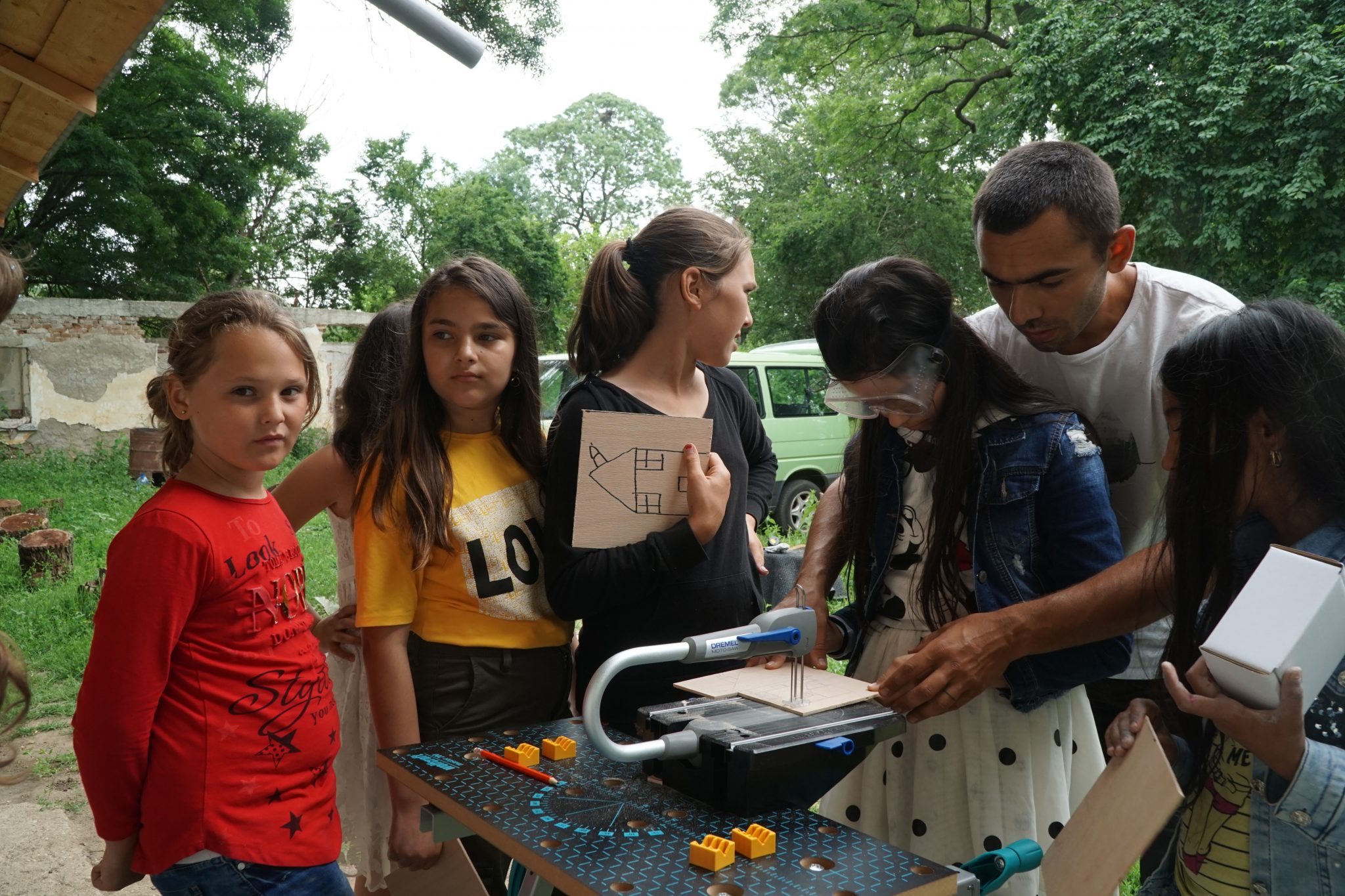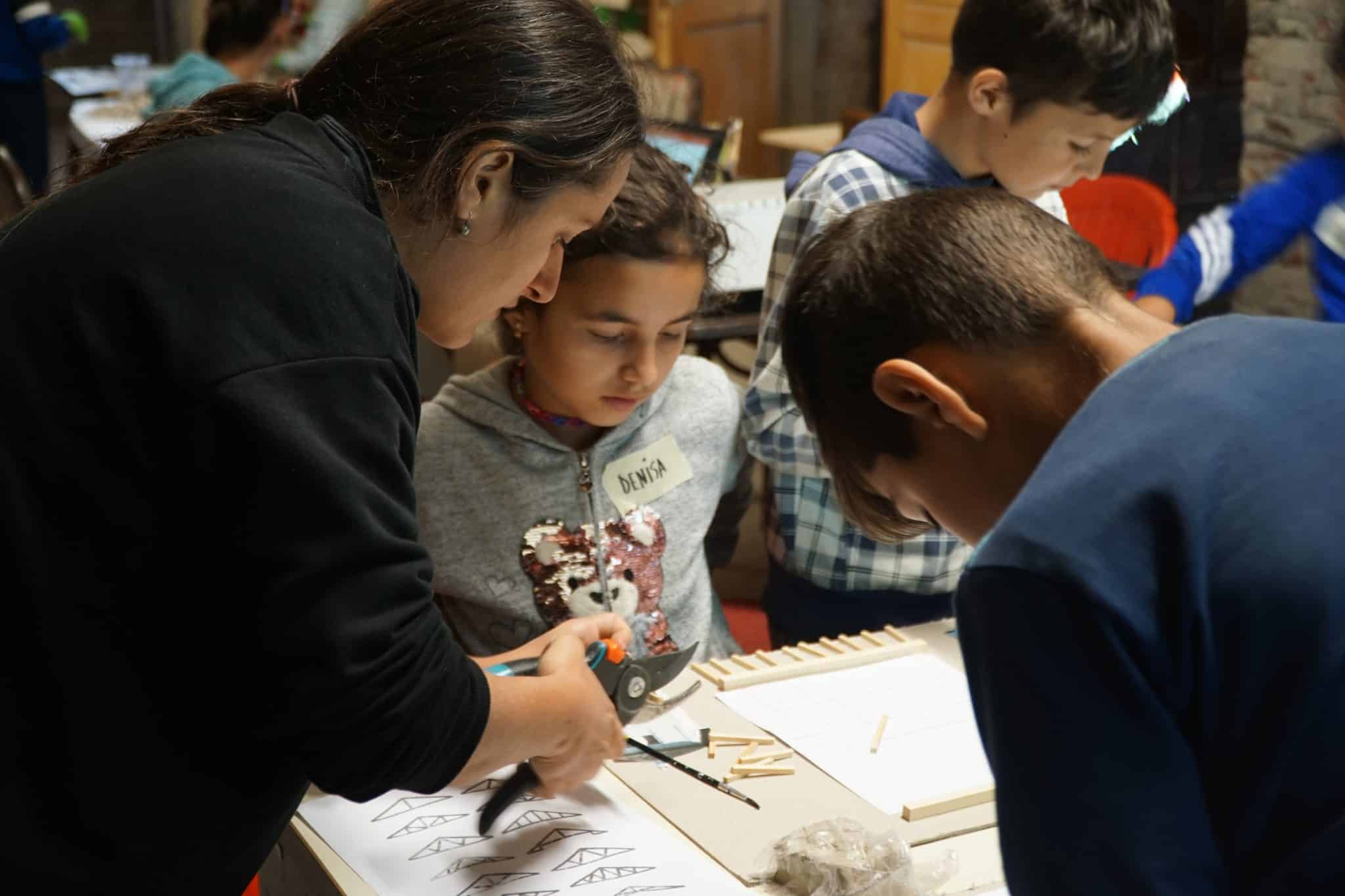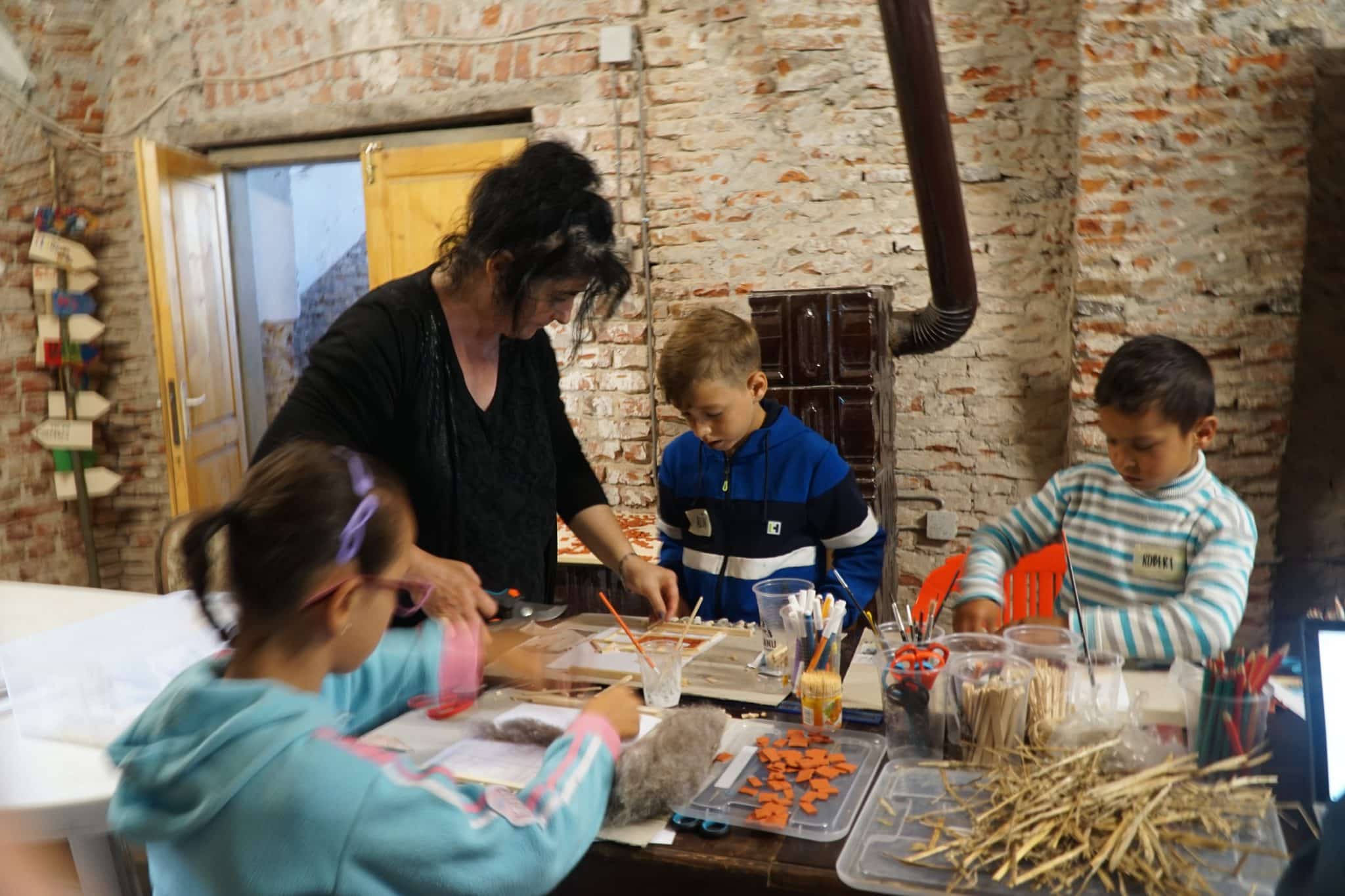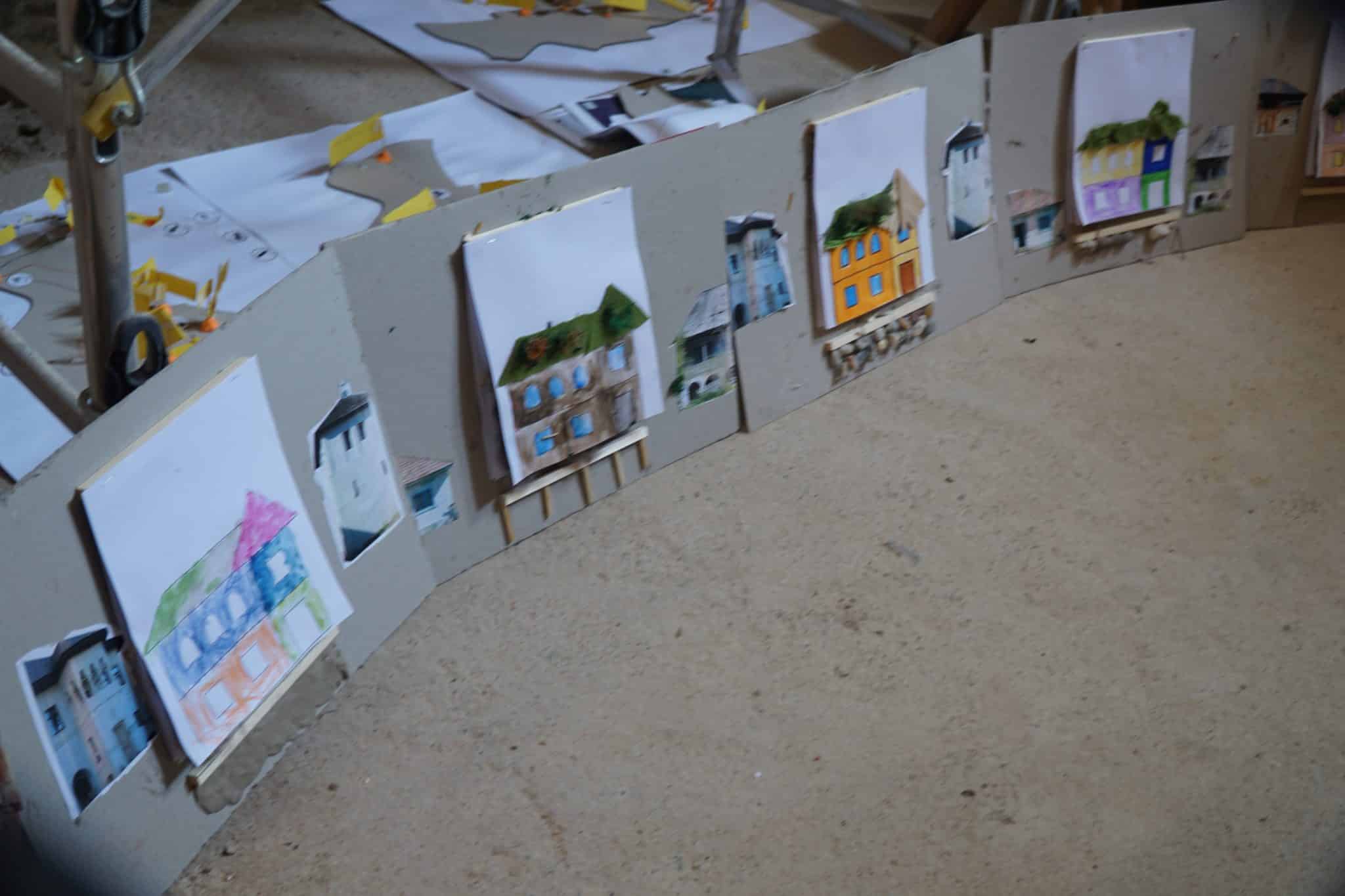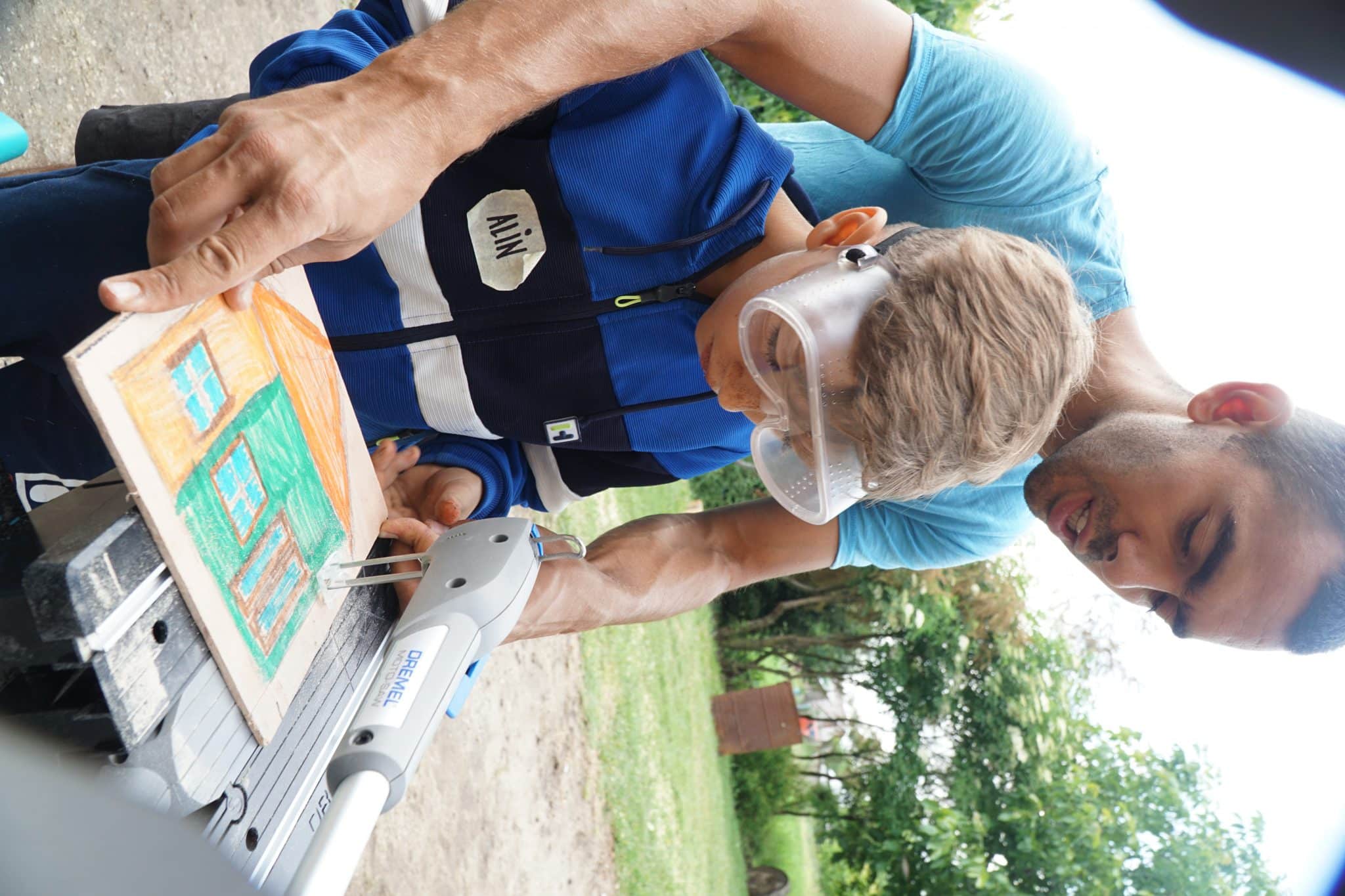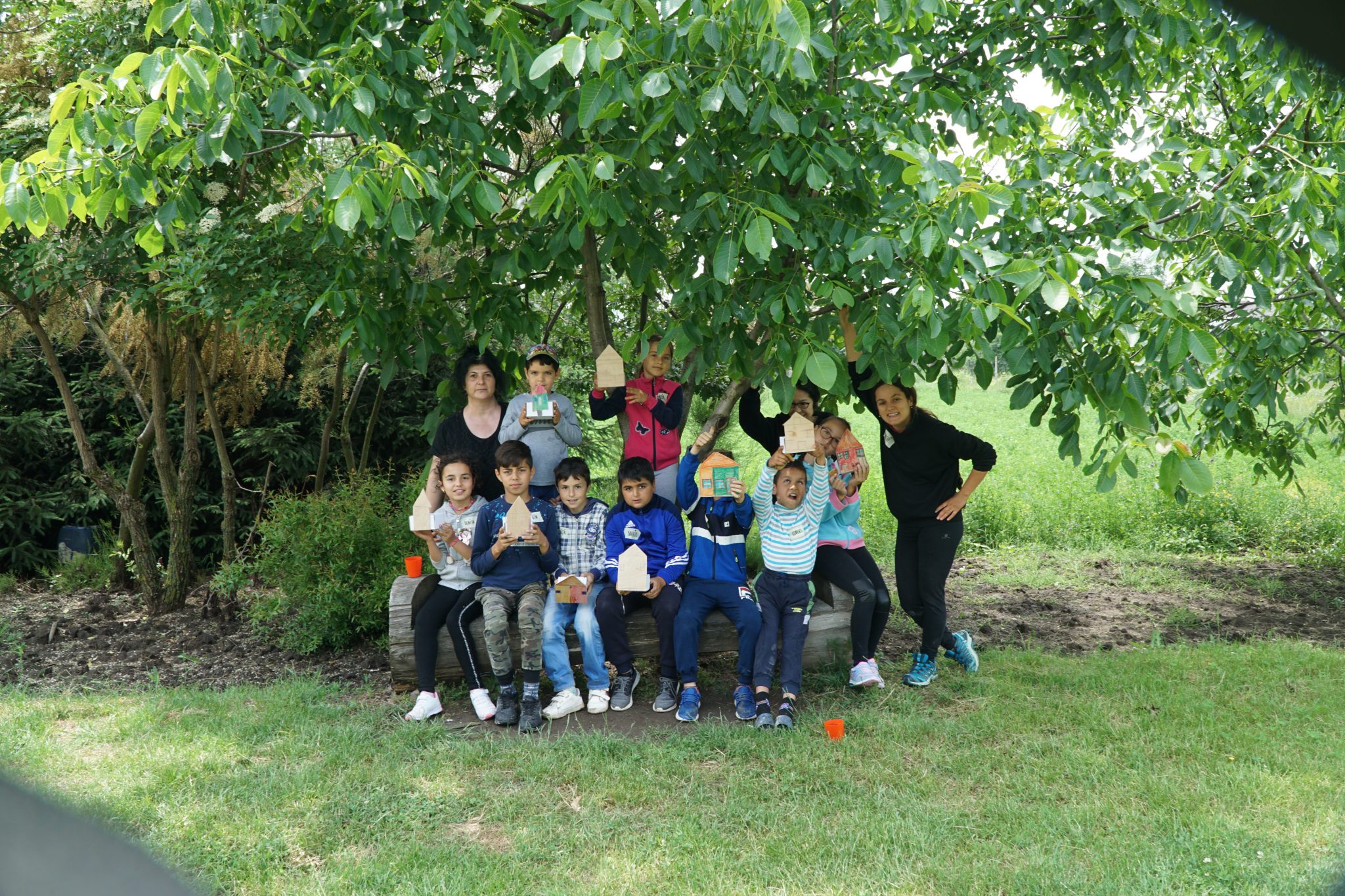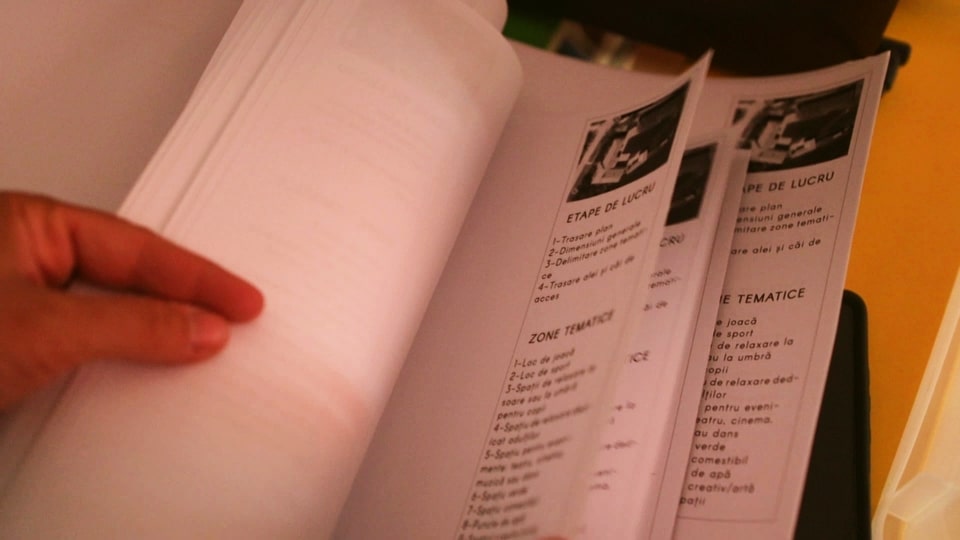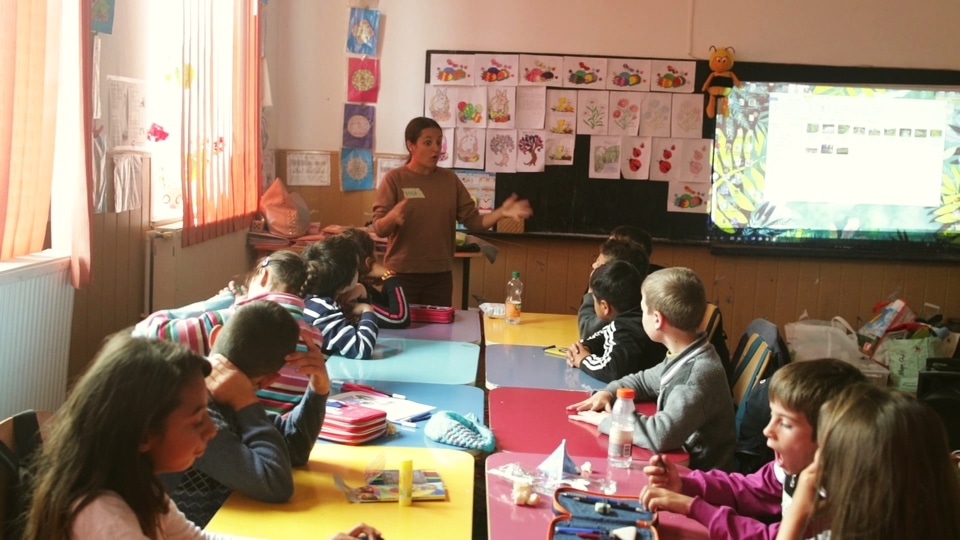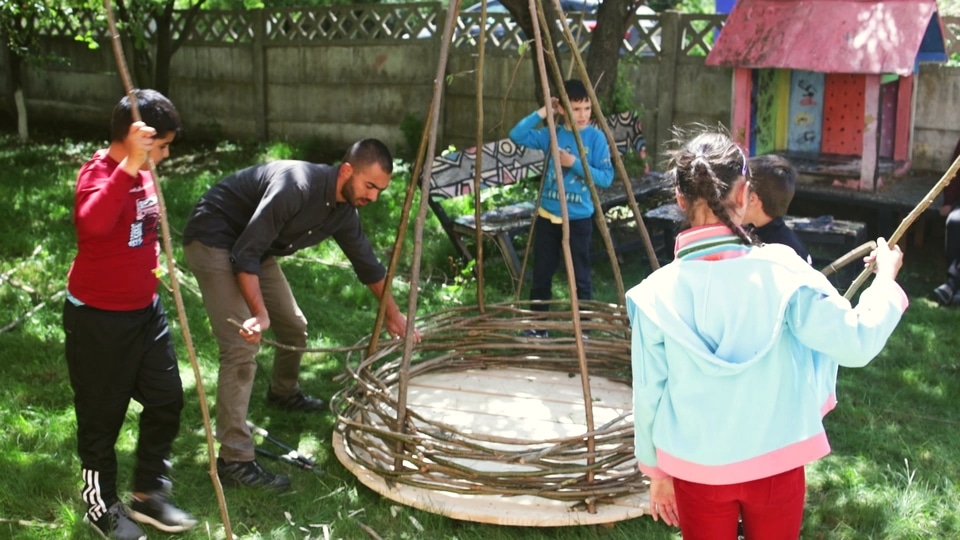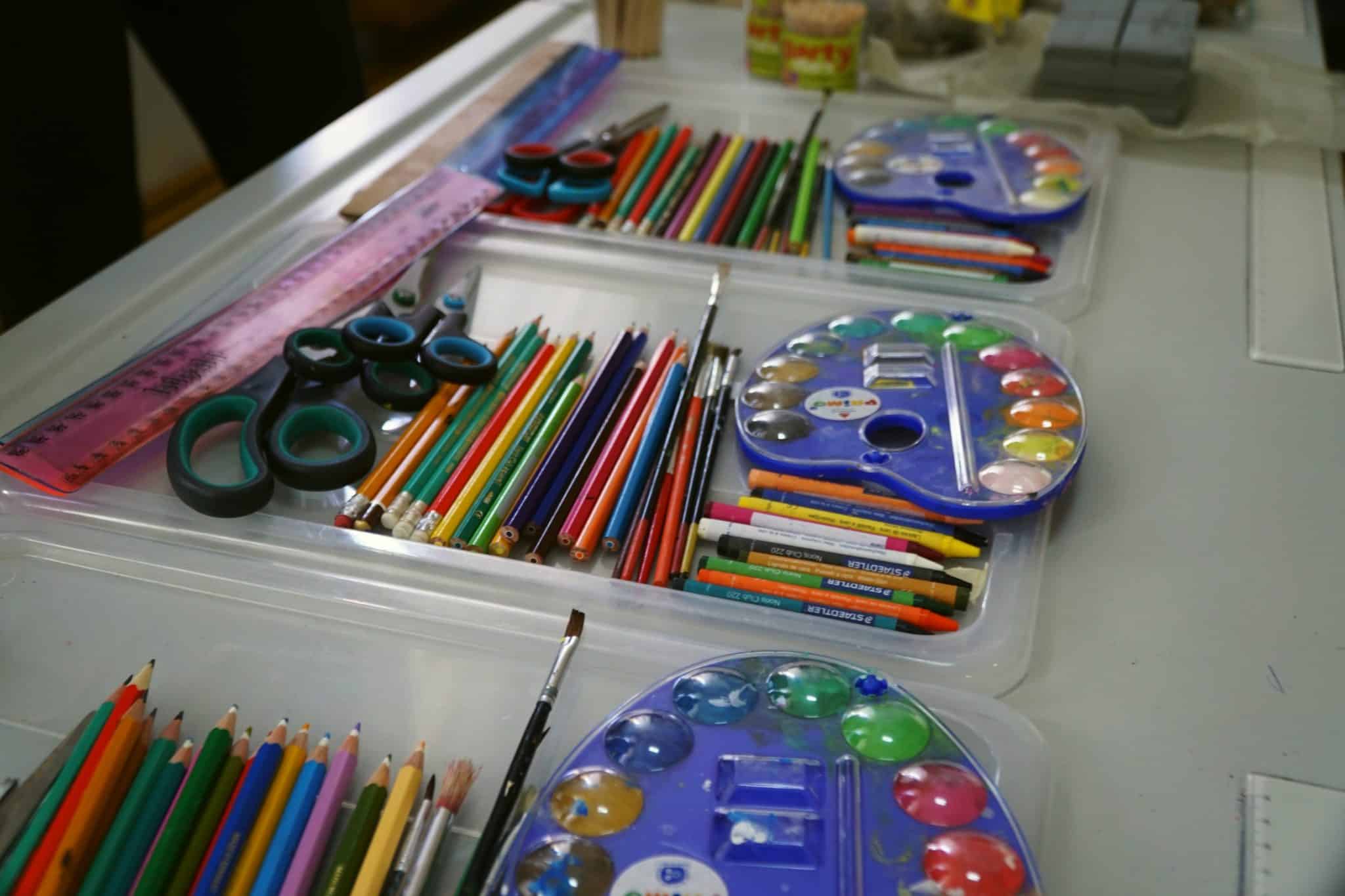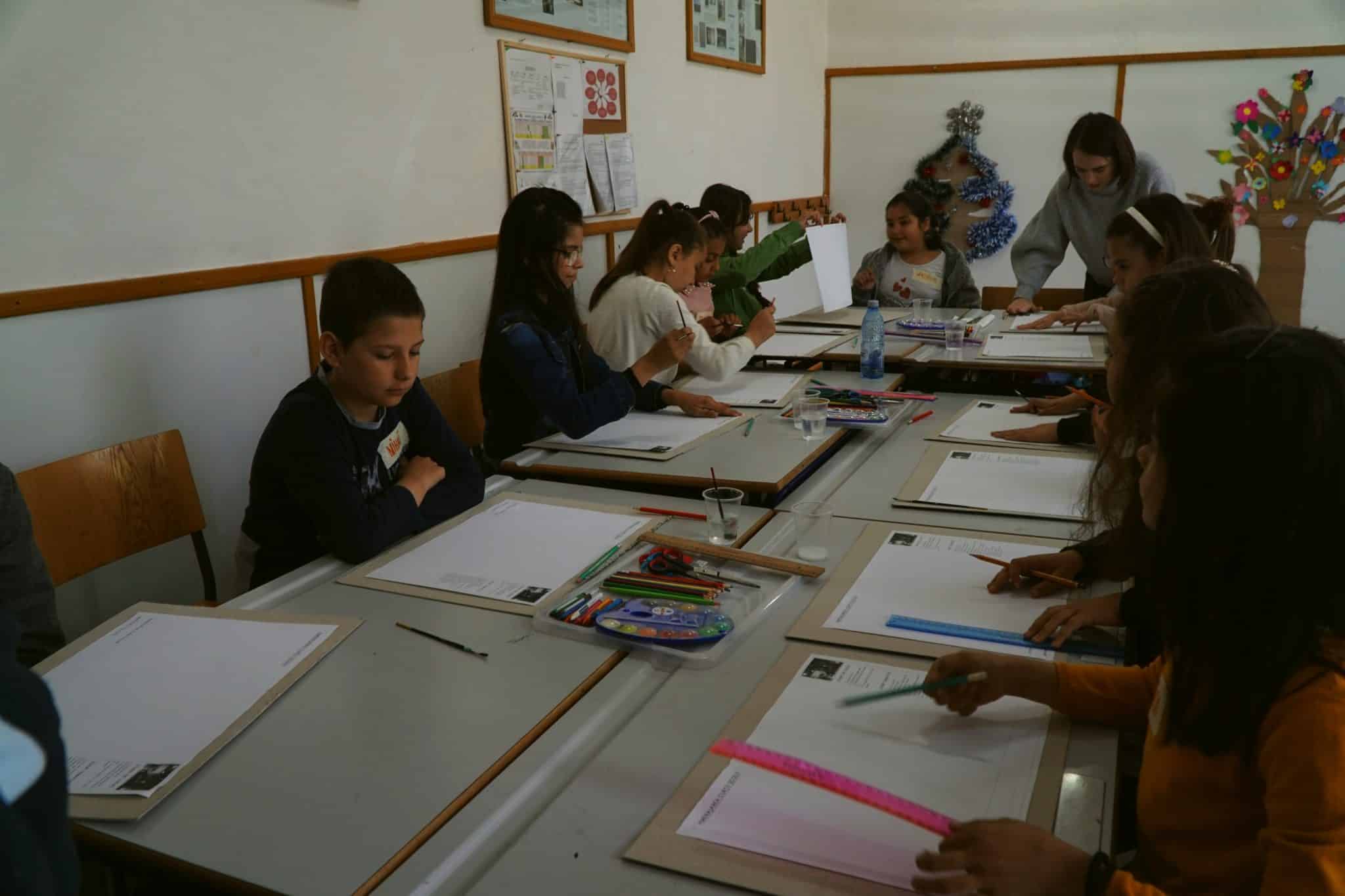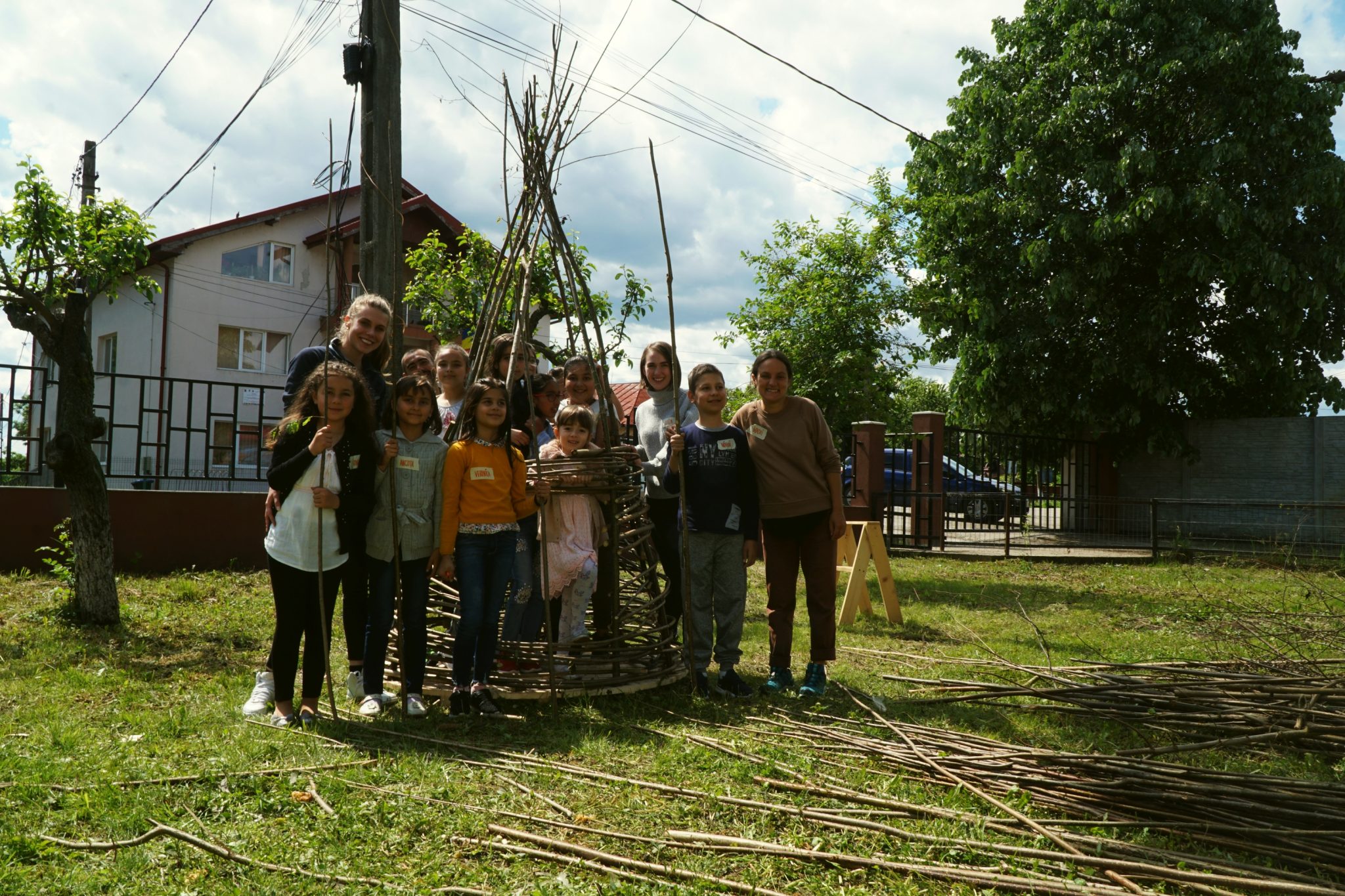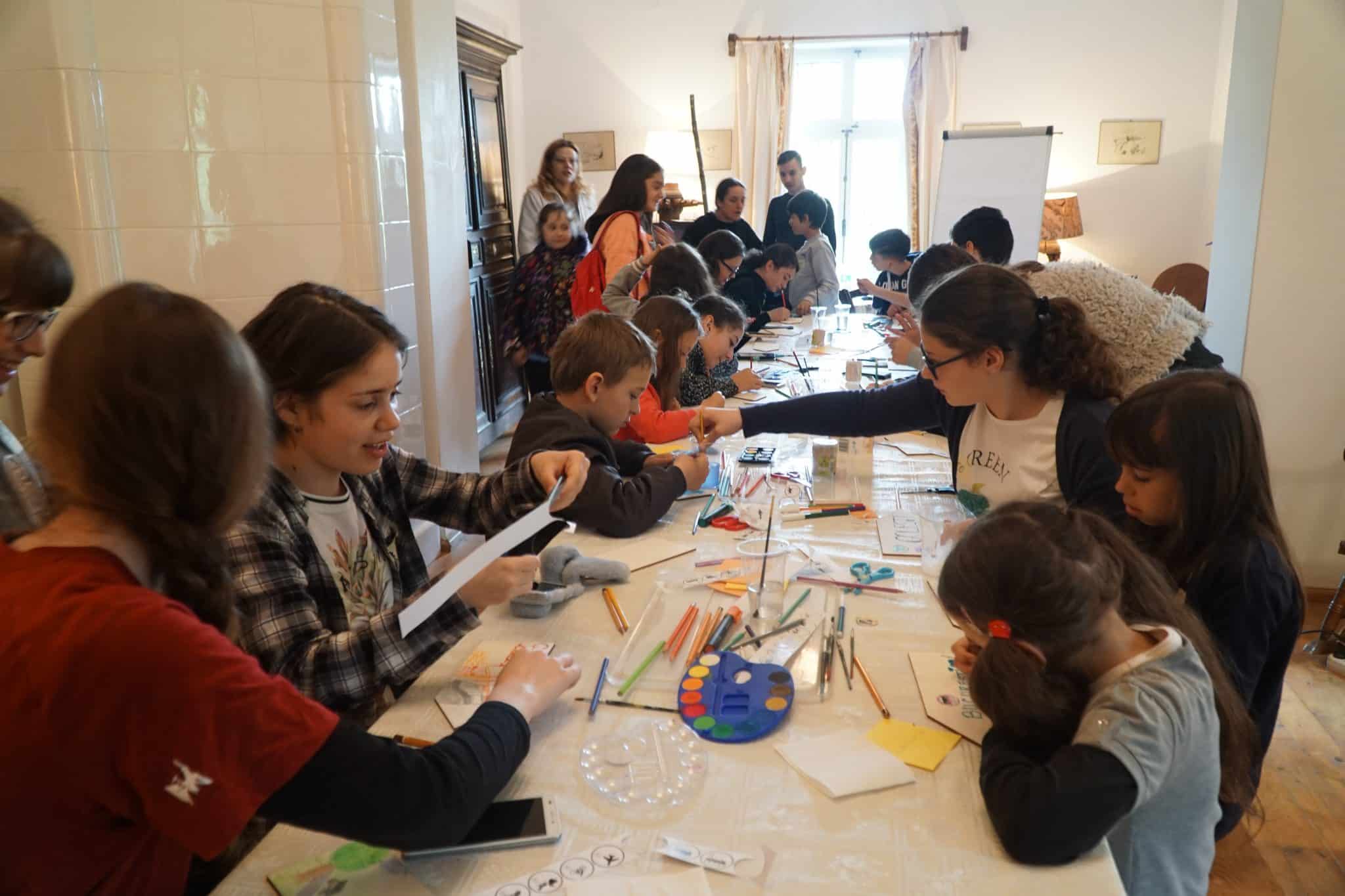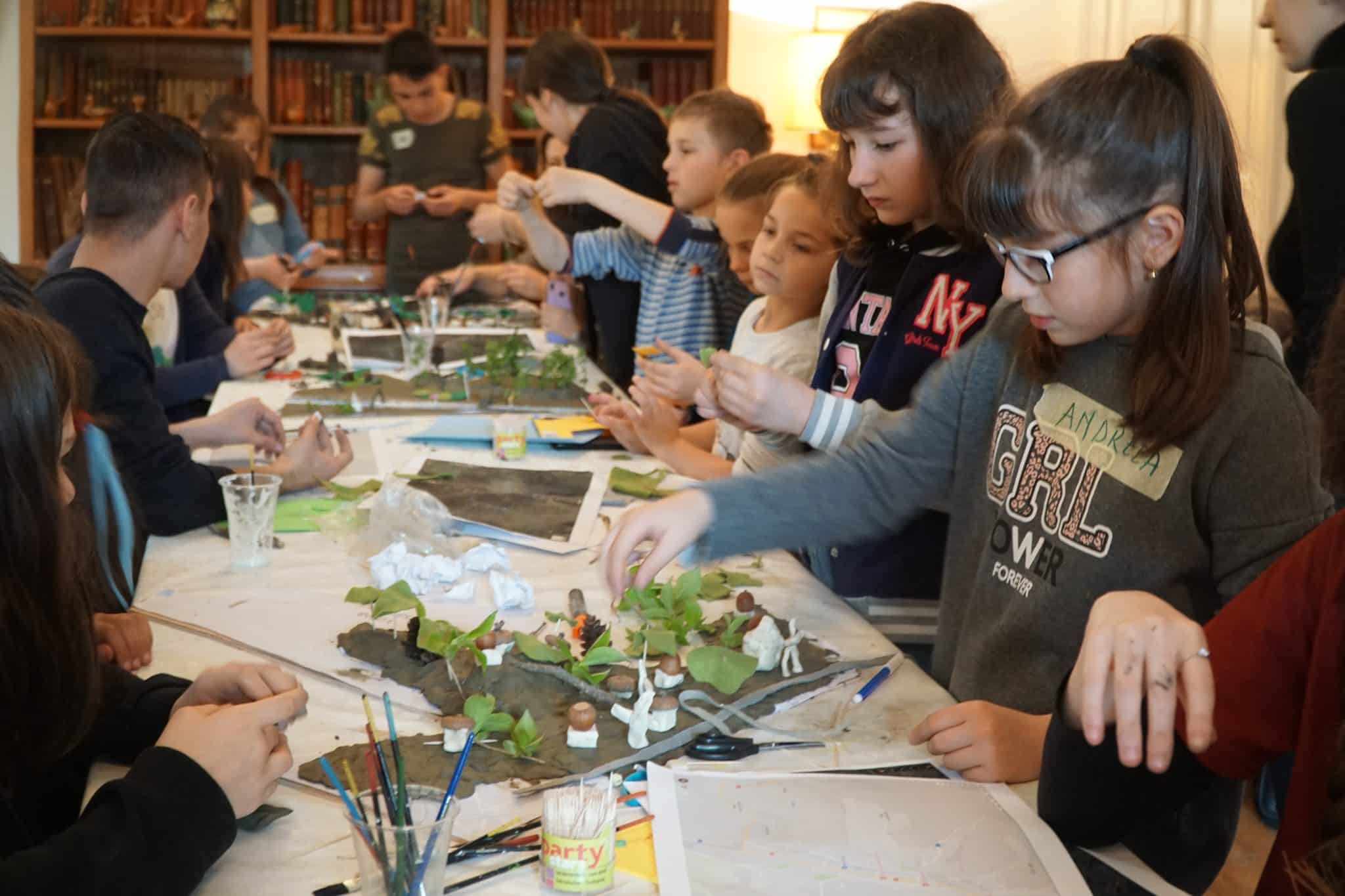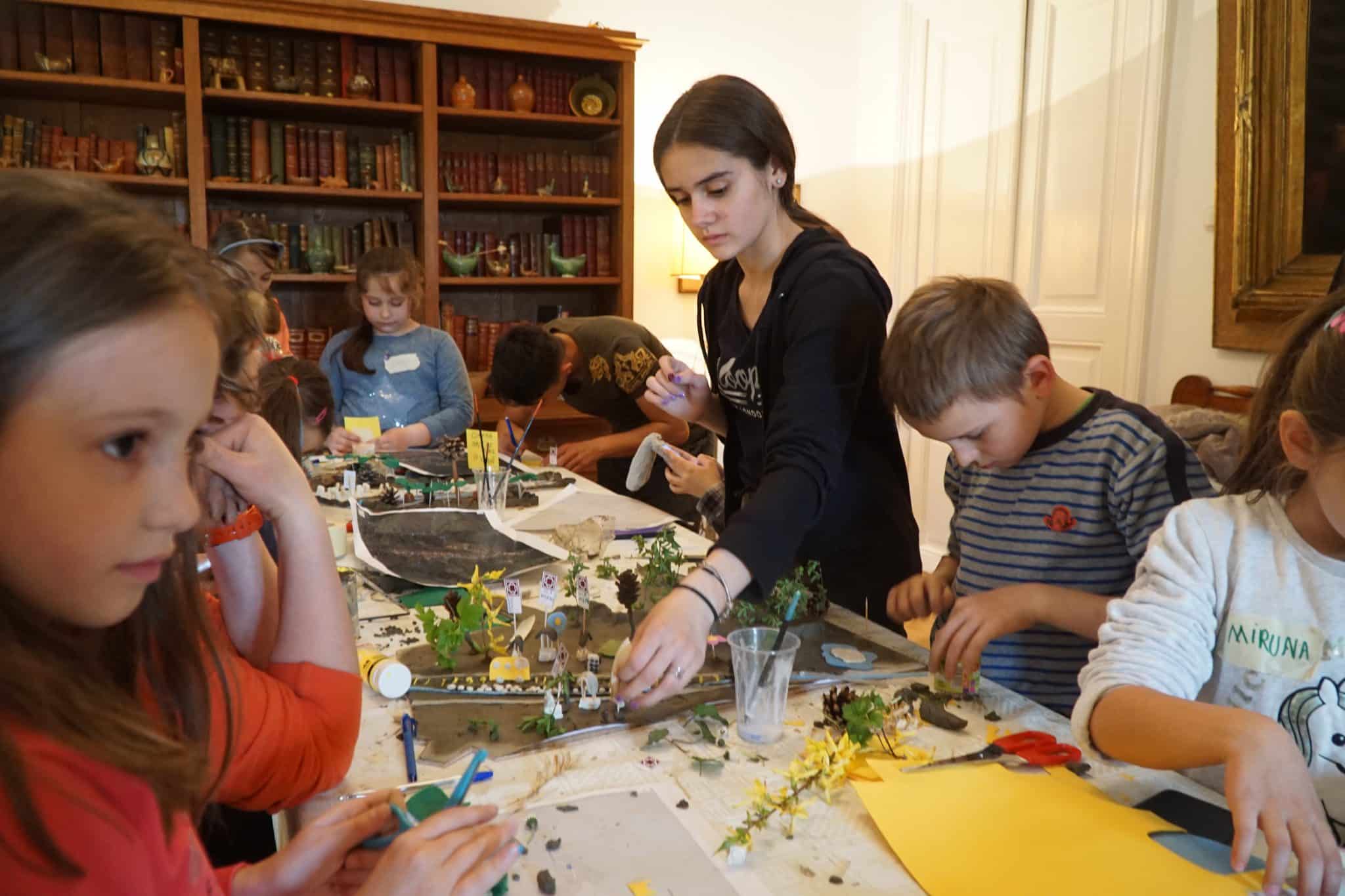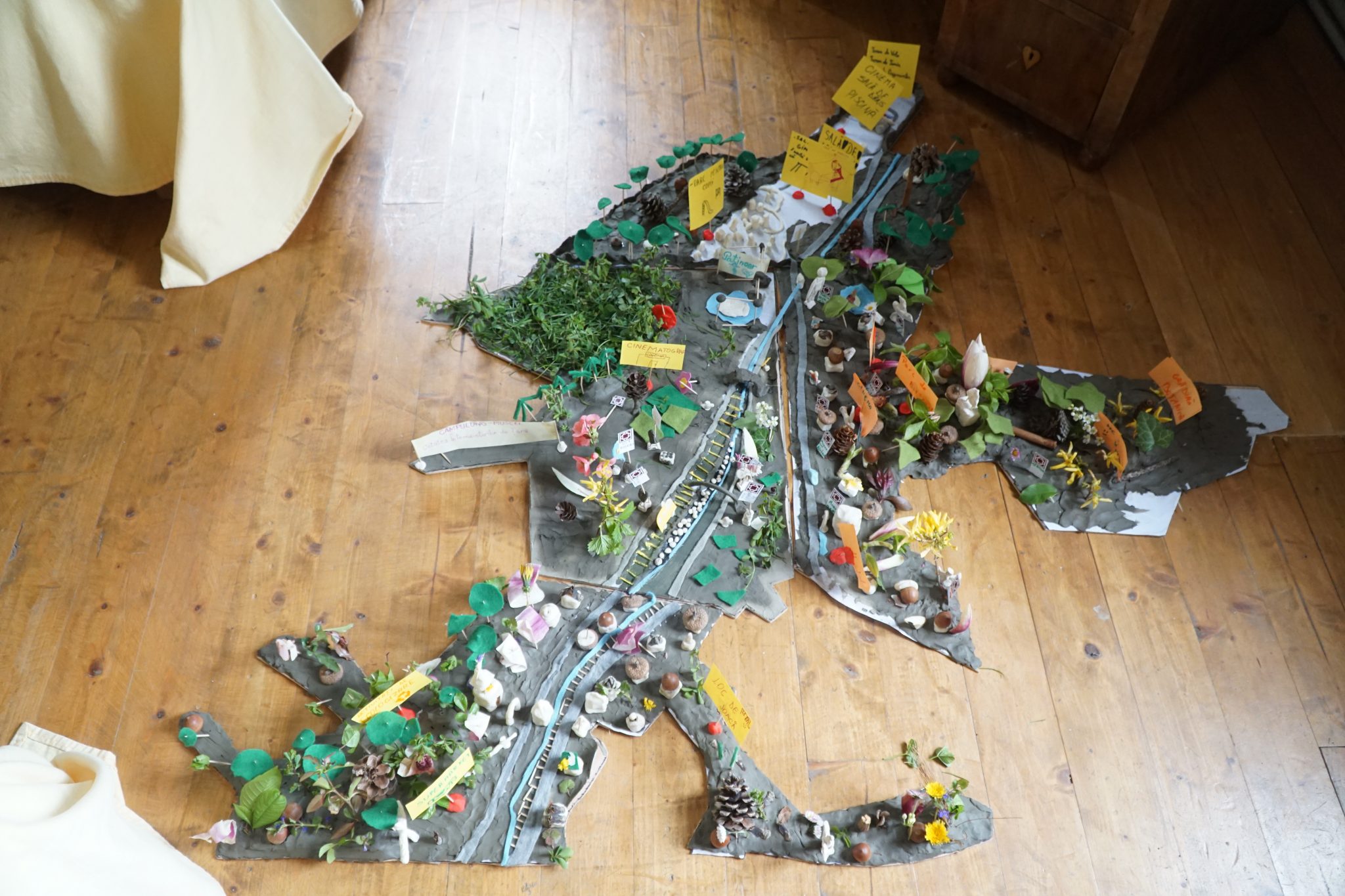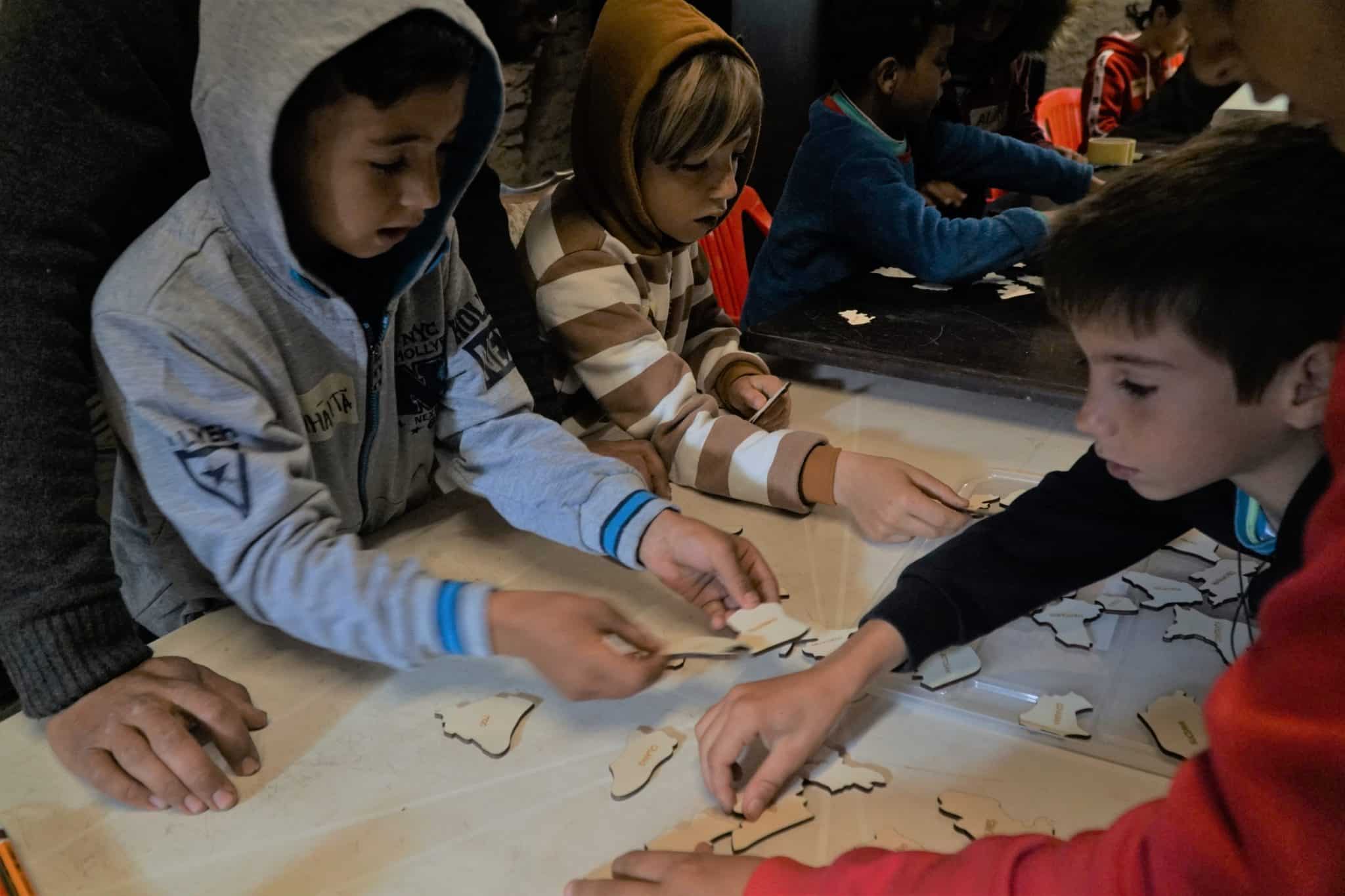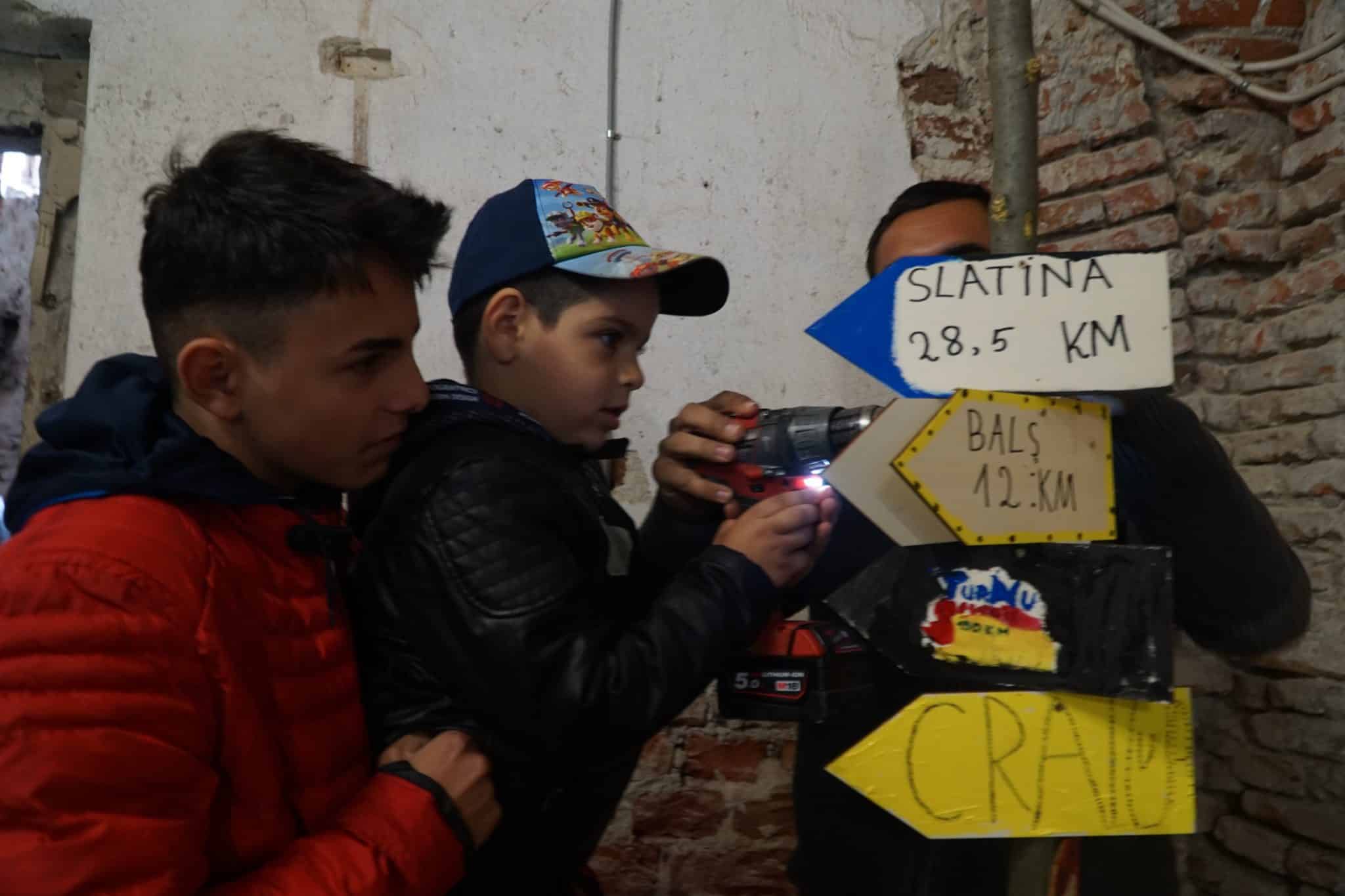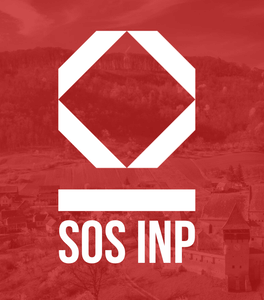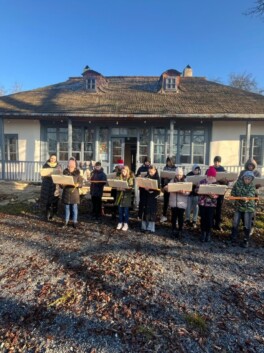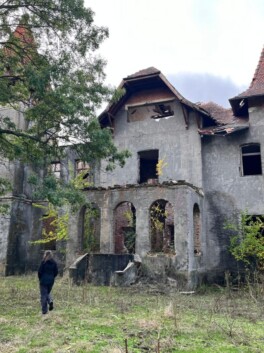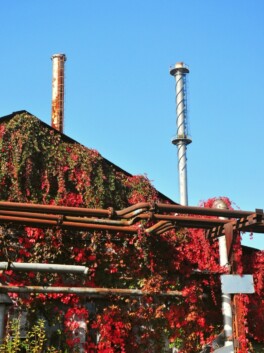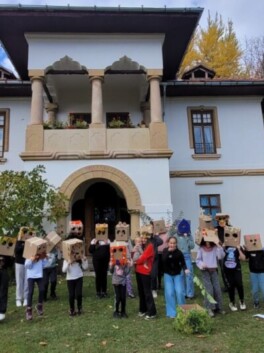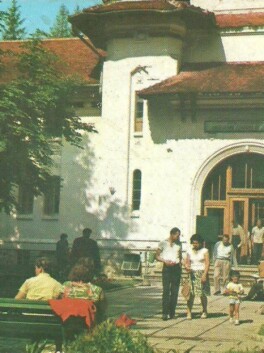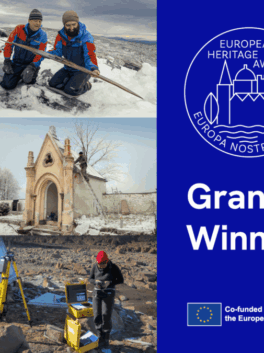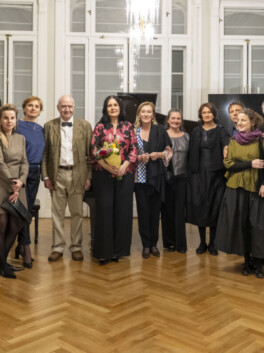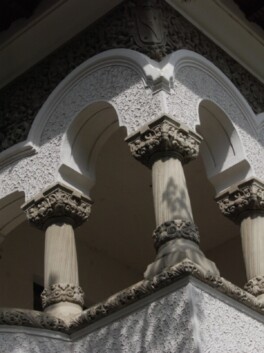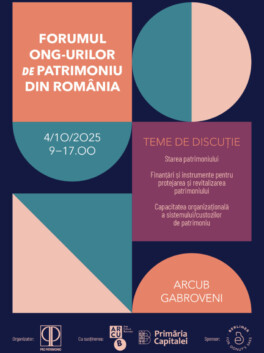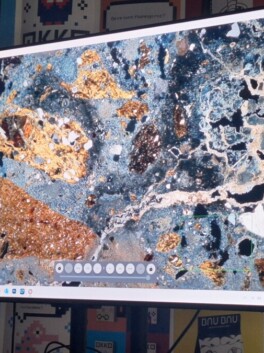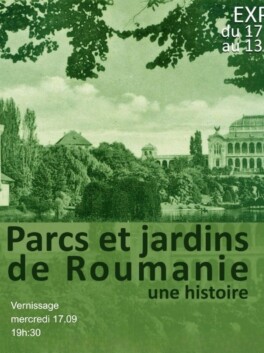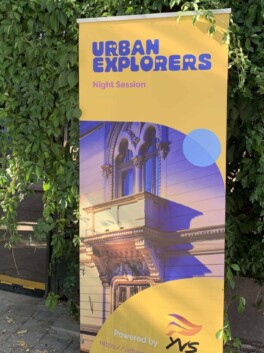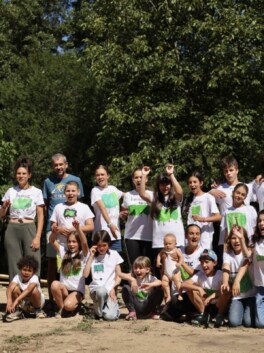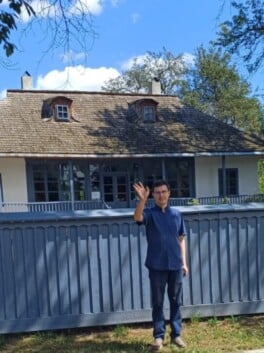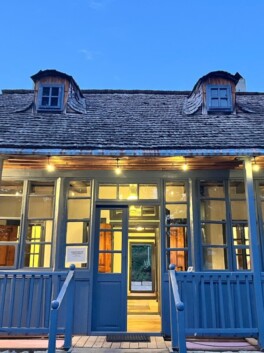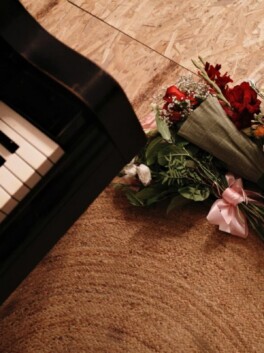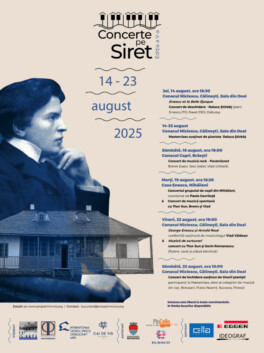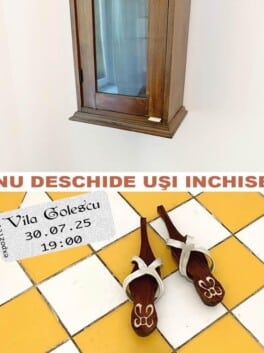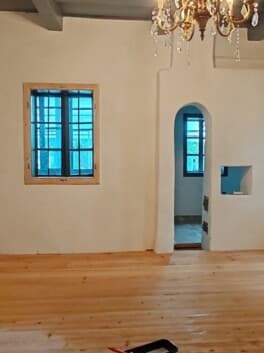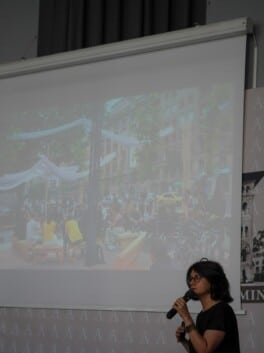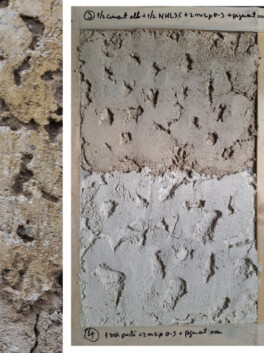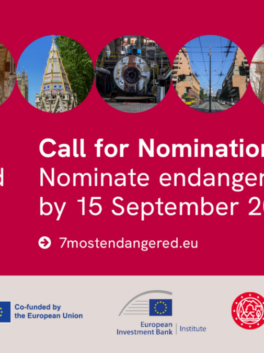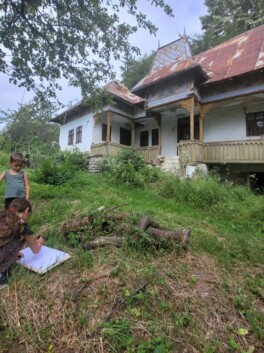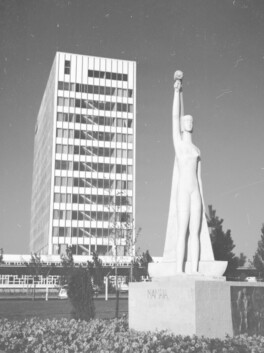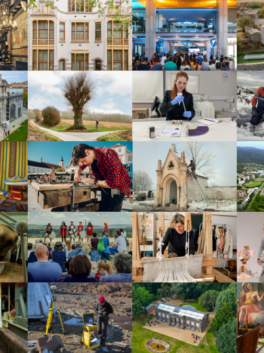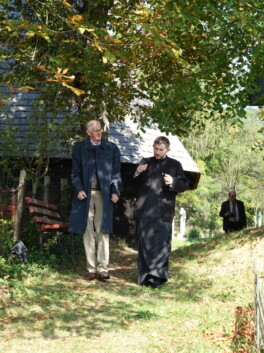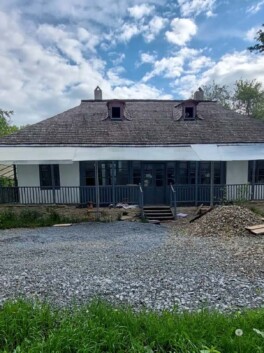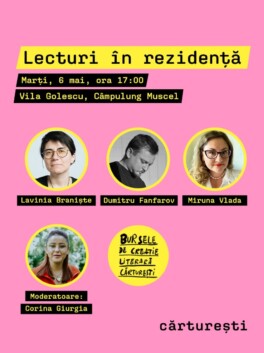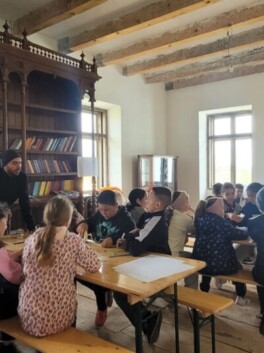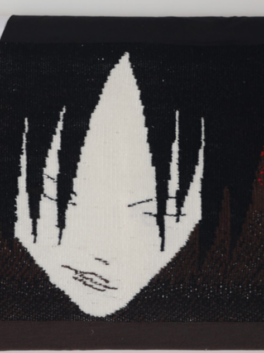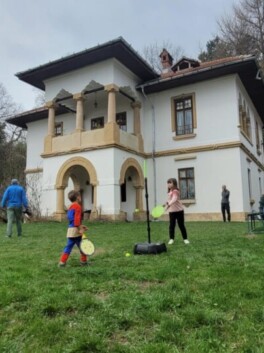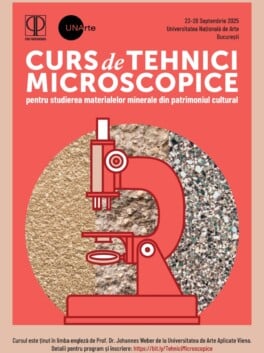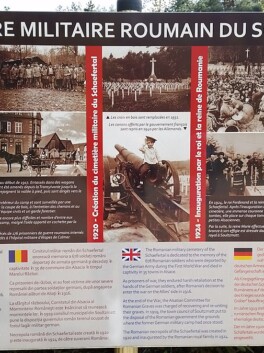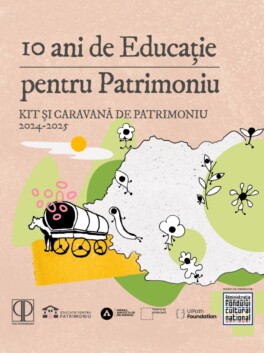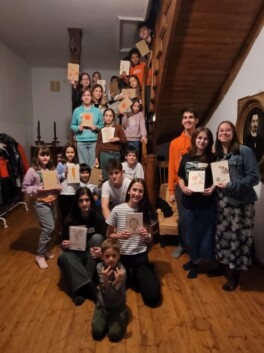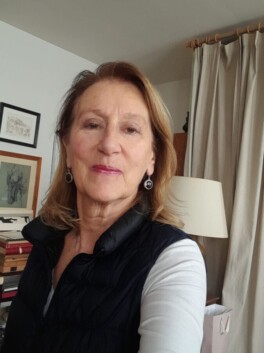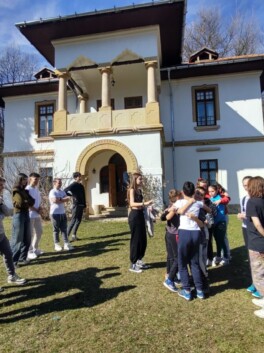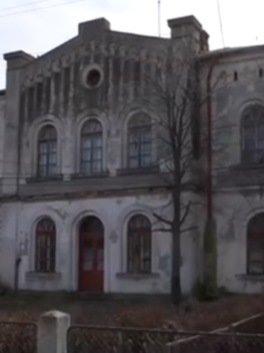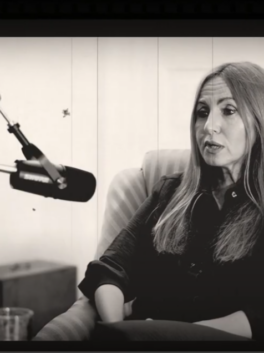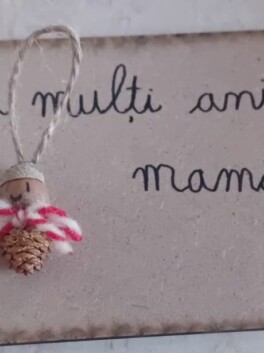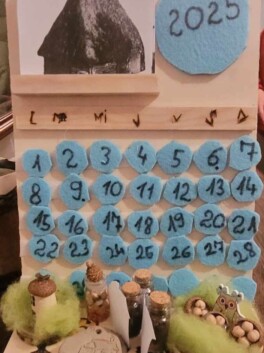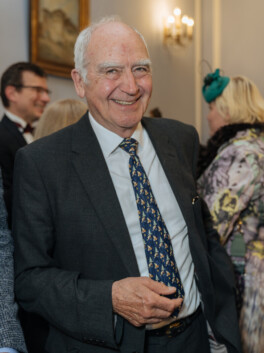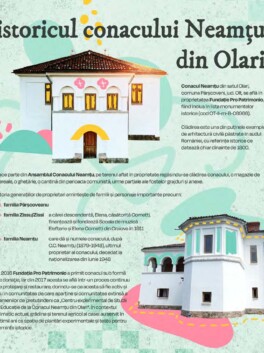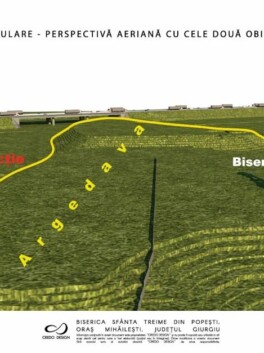
“Workshop 5: Community Festivities”, July 16-21, 2019
We dedicated the period between July 16-21 to community festivities. The workshops and the enthusiasm over the year were gathered in a two-day festival in each of the three communities around the heritage buildings in Izvoru, Olari and Câmpulung Muscel. The activities and challenges of all the workshops were recalled in an exhibition, celebrated festively and even supplemented with some new challenges.
The two-day program in each community included, with the corresponding customizations, the following activities:
1. The craft marathon with four work benches that creatively and usefully explored the manors’ world of interior decorations.
• Linocut engraving workshop – started from the story of the wallpaper decorated walls decorated and invited the children to create similar patterns using the technique of linocut and, in the end, printing them on satchels to be worn.
• The stucco workshop – after exploring the interiors decorated with different models of stuccoes, the children made their own decorative shapes from plaster and moulds ;finally, they prepared personalized protection bags with rich plants, whose colour and texture were fixed with Iron sulphate.
• The mosaic workshop – starting from various classical models of portrait-medallions, the children created their own medallions using unusual pieces of mosaic: painted beans
• The paper workshop – the walls can be decorated even with manual paper, which is why we did not hesitate to create our own models of recycled manual paper with decorations from the surrounding world of plants.
2. The animation-film workshop emphasised the local specific, the stories or places representative for each community, depending on the specificity of the place. The communities around Perticari-Davila Manor and Neamțu Manor benefited from the guidance of the animation specialist Andra Berilă to create two animations with the stories of the place. Original, friendly and not overworked, the animations followed almost all the stages of the specialist: identifying the story, structuring it into frames, making backgrounds, characters and component elements, preparing and frame-filming.
The community of Vila Golescu had already enjoyed a take on how to make an animation last year, and this year, together with the specialist Alin Iacob, they even managed to make a short film of a personal presentation of the Golescu villa and garden, which took the small filmmakers through very real stages of design and production: technical familiarity with the camera, the choice and argumentation of the frames to be filmed, deciding on lines, the framing and filming itself, voice recording and then editing in a specific program.
3. Photo exhibition with very diverse stances of the three workshop-destinations that brought together for all communities the overall image of the Foundation’s initiatives at all three mansions.
4. A gastronomic contest addressed firstly to the mothers of the children, but equally to any interested member of the community, after which, through multiple tastings and sincere votes, the winners left home with a household item: a mixer. Salted cakes and dishes far exceeded our expectations, encouraging us to believe that this initiative could grow in the future by supporting the educational activities at the mansions in a pleasant and tasty way.
5. Film projection in the manors’ yard, in the company of the nice animated feature film ODDSOCKEATERS, broadcast in partnership with FREEALIZE.
6. Evening out in the open air, as is suitable for the end of a camp, in the courtyard of the three manors, where the brave and the curious alike not only learned to set up tents, but also used them to spend the night with the camp team. For most of the children, sleeping in the tent was an unforgettable experience, which proved to be the culmination of the small festival-workshop and which often gave rise to the question and challenge: “when will you organize a camp at the manors? .
The activities followed one another with applause, running, exploring places, picnics, snacks, happy visits from parents and teachers, lots of enthusiasm and exciting requests to repeat the experience from children and the community alike.
We enjoyed the support of the close members of the community, the help of parents, teachers and especially volunteers, Luiza Anna and Ana Maria Apostoiu, we enjoyed the culinary gifts received to complete the atmosphere, but most of all the confidence and enthusiasm received from the part of the children to continue our educational efforts, after this year, with even more expectations.
We are going to gather the experiences gained this year in an online educational guide, which we hope to be of help to with initiative and even launch a small series of educational objects and games that will tell and support in the future a part of the foundation’s activities.
Cultural project co-financed by AFCN. The project does not necessarily represent the position of the Administration of the National Cultural Fund. AFCN is not responsible for the content of the project or how the results of the project can be used. These are entirely the responsibility of the beneficiary of the financing.
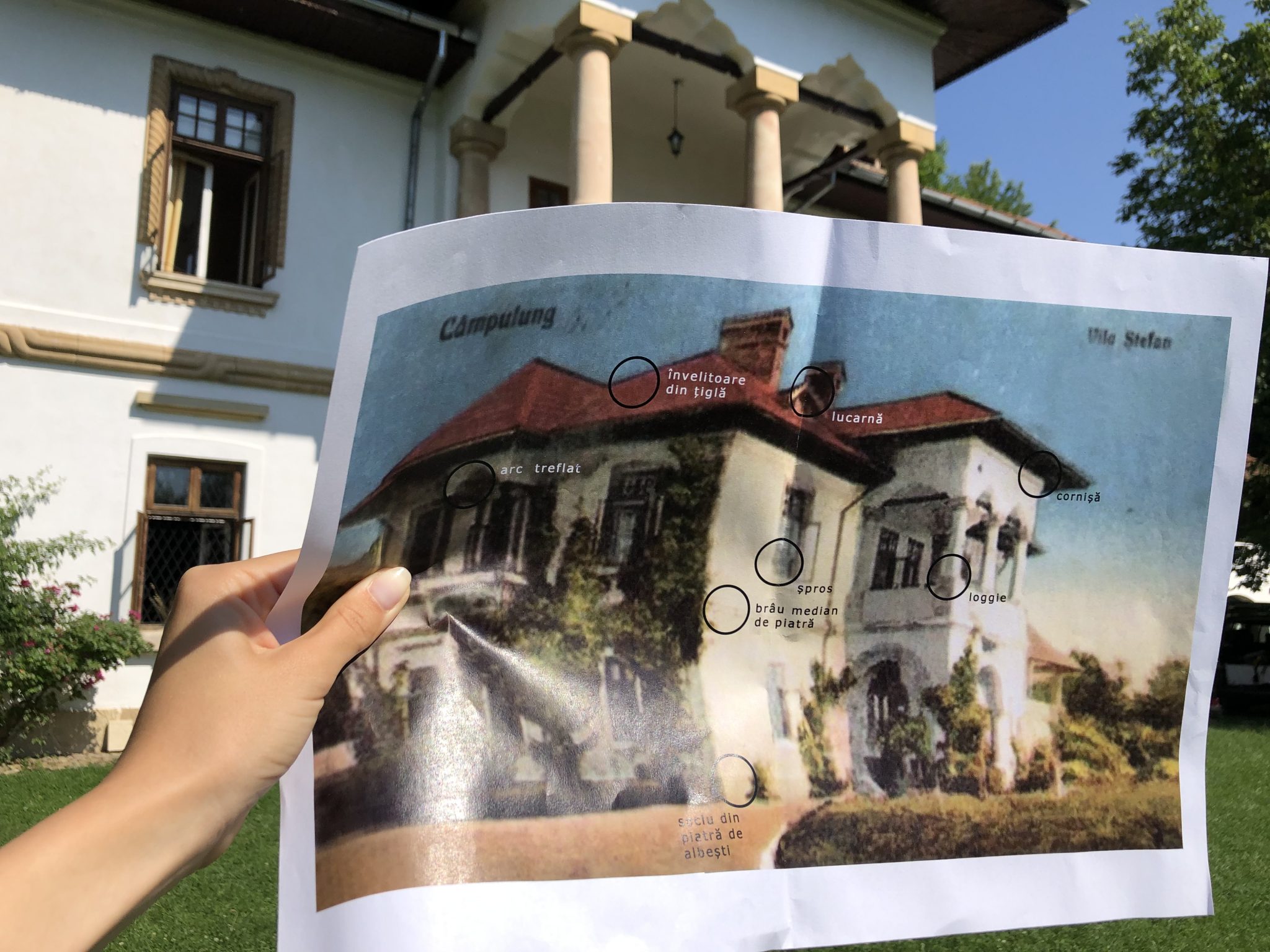
“Workshop 4: Treasure Hunt,” May 29 – June 2, 2019
On the first holiday weekend, June 14-16, we started the workshop caravan at the three mansions. This time, our activities moved out in the open to enjoy the warm days of this season.
We set out to discover the hidden histories of the mansions through a timed treasure-hunt game, with as diverse and dynamic ostacles as possible, be they sports, cultural, creative or DIY.
The competition unexpectedly motivated all members of the children’s teams, their captains, supporting teachers and parents in the gallery. In order to get the clues needed to draw the whole story, the children had to get past:
1. the sports challenge – running, pushing logs or pulling straw bales, balancing on an “electric wire”, walking like a dwarf and finally, recovering a written message from a tree;
2. archery challenge;
3. speed drawing challenge – a relay race with pencil and sharp attention whose theme was the manor’s main facade in as much detail as possible;
4. the challenge to measure the height and the width of the manor by estimating with landmarks and by orientation, which implied localizing the manor according to the cardinal points;
5. identification of plants according to their place on the manor’s garden map;
6. the challenge to make a poster that promotes the manor together with a representative plant;
7. the challenge of architectural details – correlation of specialized terms that describe constructive elements of the manors with their place in the vintage photo of the three constructions;
8. the funny challenge, with two coordination challenges for the teams to obtain the desired clue in a unique way;
9. the creative challenge that starting from a short story involved making a famous character from the manor using materials such as wood, thread, vegetation and textiles.
All three communities managed to reconstruct the stories from the mansion exploring them in a fun way, got closer to the famous characters who animated the manors in the past, such as Elena Perticari-Davila, George Zissi – “Prince of Olari” – and Vasile Golescu, strengthened friendships as a team and offered us the opportunity to enjoy not only the experience of working together, but also the enthusiasm and emotional requests to continue the activities of the manor in the future. We celebrated the end of the adventures with the DIY of souvenir diplomas with perforated manor facades and the stories won as a decoration.
Cultural project co-financed by AFCN. The project does not necessarily represent the position of the Administration of the National Cultural Fund. AFCN is not responsible for the content of the project or how the results of the project can be used. These are entirely the responsibility of the beneficiary of the financing.
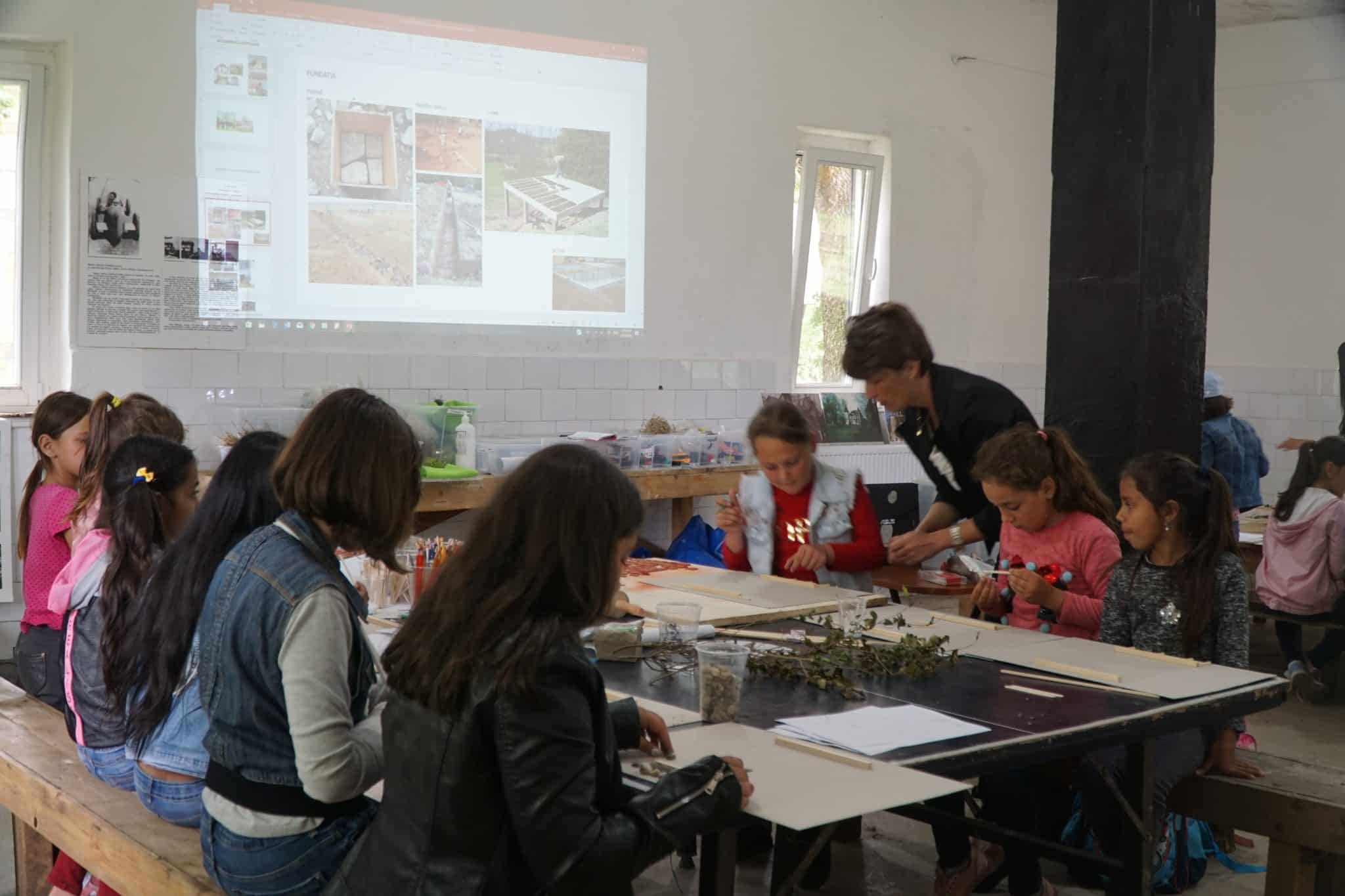
“Workshop 3: The Architect,” May 29 – June 2, 2019
The meetings of May 29 – June 2 brought us closer to what an architect understands by “beautiful house”, how he can obtain one, what craftsmen he will work with and what materials he will use. At the same time, we agreed that a valuable house is also a house full of stories, and that is why we chose a creative approach even to the idea of “home”.
The communities of Izvoru, Olari and Câmpulung Muscel responded unexpectedly well to the challenges not exactly easy to build their own models of “beautiful” houses in different stages of construction, using local materials and alternative construction techniques: both old and contemporary. The project “at home” wanted to be a replica of their own house, attached to a personal box of memories, in which the children were invited to hide their most beautiful memories gathered in the family space. The project also involved testing a new mechanized tool for wooden tracery, namely the electric saw.
And since it was the 1st of June, we had biscuits, juice and the joy at the end of a project… along with the promise to meet again on new Pro Patrimonio heritage adventures.
Biscuits, juices and merry-go-round, as of June 1 … and the promise to see you again with new heritage adventures made by Pro Patrimonio!
Cultural project co-financed by AFCN. The project does not necessarily represent the position of the Administration of the National Cultural Fund. AFCN is not responsible for the content of the project or how the results of the project can be used. These are entirely the responsibility of the beneficiary of the financing.
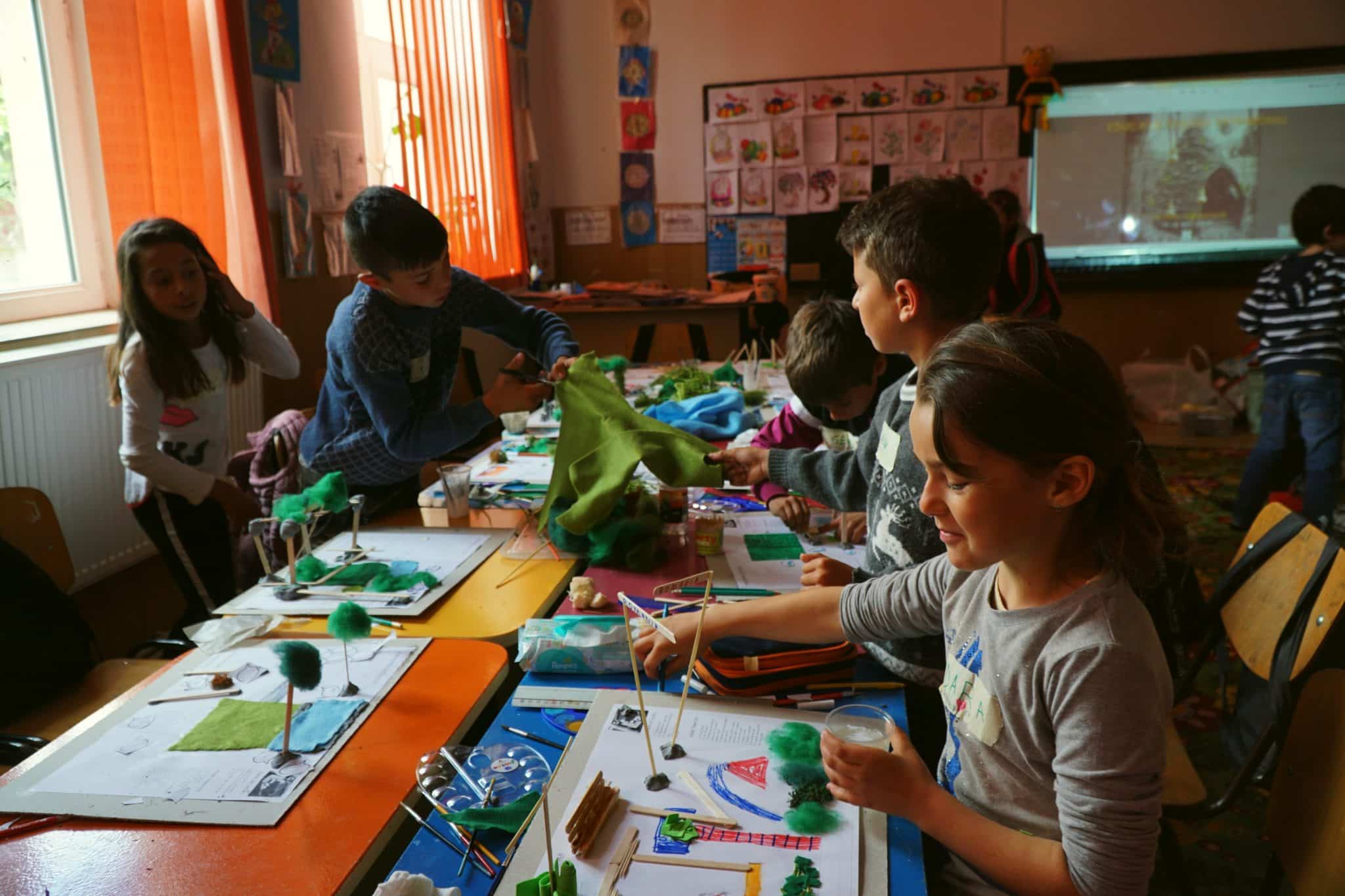
“Workshop 2: The Landscape Designer” May 10-12, 2019
The project „Education for Heritage” gathered a new string of stories and adventures between May 10 and 12 2019 in the school courtyards in the local communities of Izvoru, Olari and Câmpulung Muscel. The children got acquainted with the world of landscape designers and found out what they do and why they are useful. Then got to play their role giving creative, responsible and sympathetic responses to the challenge of having to set up their own school yards according to custom-made plans.
We then changed the scale of the works and aimed for a human-sized model, namely an outdoor pavilion of hazelnuts. We chose the most suitable place in the school yard and started the construction of a small space for relaxing, playing and growing vegetables. We trained their attention and patience to be able to carefully handle not only the reeds, but also the different tools needed: scissors, drill or “mouse”. In parallel, we worked to create a series of seedlings that the children will take care of and then plant with us right at the base of the structure, the wicker pavilion thus becoming a growth support for beans, cucumbers, pumpkins or peas.
The work was not without reward, so that the small landscape designers finally had the opportunity to even experience part of the future culinary micro-landscape created, testing some of the freshly planted vegetables in the form of vegetarian wrappings with hot pies and unique tastes.
We enjoyed around six hours of patience and enthusiasm from the children of each workshop held in the three communities. We know for sure that we planted the seeds of possible future landscape designers in over 15 people from each location and that we felt excellent together with teachers, parents, volunteers and other helpers who appeared during one of the most beautiful building adventures in the series of heritage meetings around Perticari-Davila Manor, Neamțu Manor and Golescu Villa.
We thank the dedicated team of volunteers, Ana Luiza Simion and Anda Tănase, the specialist behind the video camera, Alin Iacob and his little assistant Andrei, and especially the teachers and school principals who have given us all the support necessary to build the three pavilions in the courtyards of the schools from Olari, Izvoru and from the “Carol I” Pedagogical High School in Câmpulung Muscel.
Cultural project co-financed by AFCN. The project does not necessarily represent the position of the Administration of the National Cultural Fund. AFCN is not responsible for the content of the project or how the results of the project can be used. These are entirely the responsibility of the beneficiary of the financing.
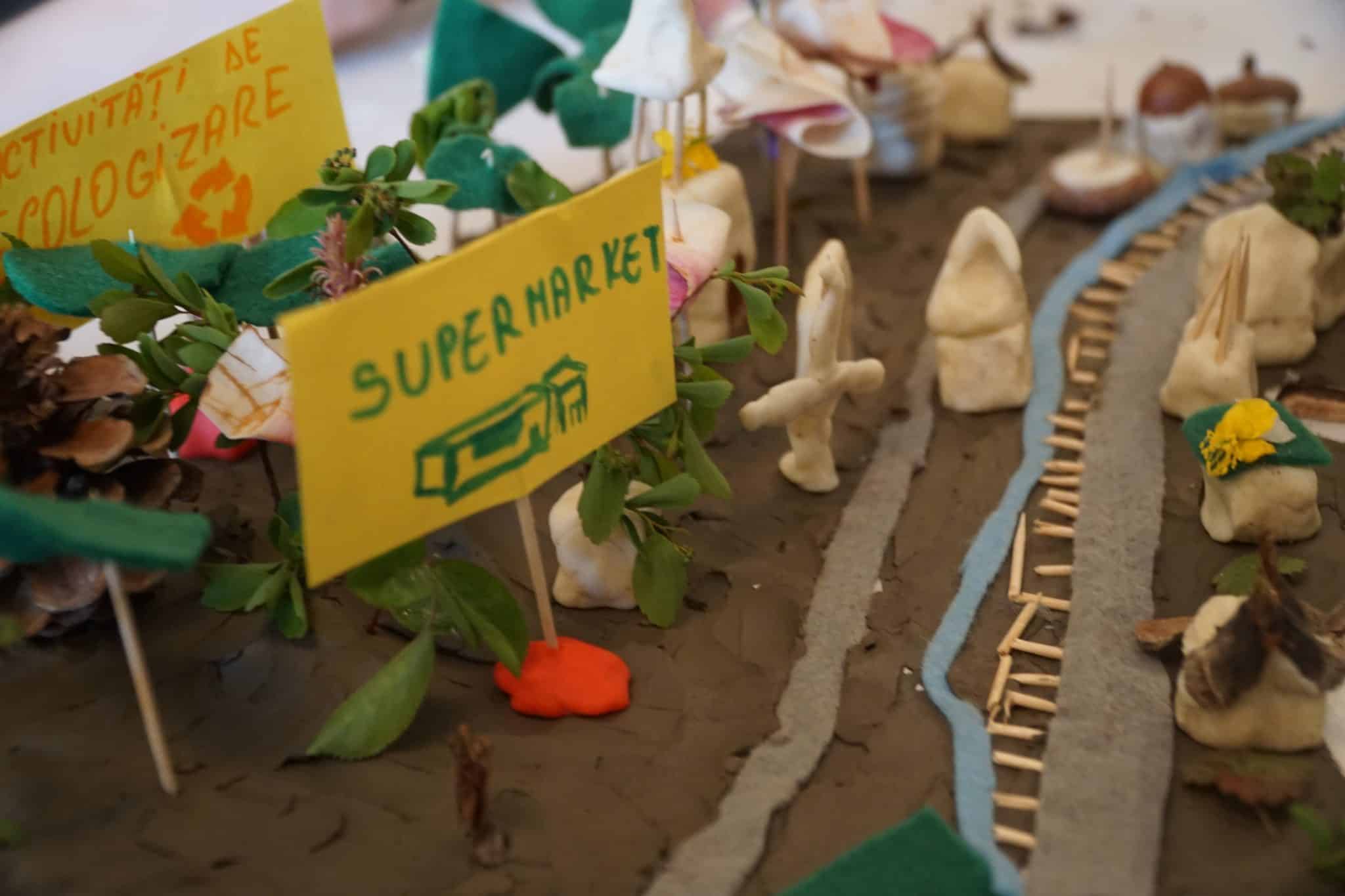
“Workshop 1: The Urban Planner”, 20 to 21 April 2019
The meetings of the heritage workshops have turned into an educational module dedicated to the communities of children gathered around the three monuments we deal with. The project started this year on April 20-21 with workshops on the theme “the urban planner” held in Olari and Câmpulung Muscel.
The children were enthusiastic about the new discoveries, the theoretical foundation thus became friendlier due to the practical perspective: they established where they are on the Romanian map and marked a few cultural exploration options around the manor and the villa with the indications of distance and means of transport available, thus making county cultural maps and tourist indicator posts.
Emotional maps were the means by which the children from Olari could outline their own universe with the spaces they love in the village and the city, and the great model was the challenge by means which the dwellers of Câmpulung managed to overlap the built and green layers of the city, to mark the access roads, the water route, heritage houses, landmark buildings, but especially they marked the interventions they would propose in the city according to the identified needs
The workshops gathered 15 children and a teacher in the community from Olari and almost 30 children and 3 teachers in the community from Câmpulung Muscel.
Cultural project co-financed by AFCN. The project does not necessarily represent the position of the Administration of the National Cultural Fund. AFCN is not responsible for the content of the project or how the results of the project can be used. These are entirely the responsibility of the beneficiary of the financing.
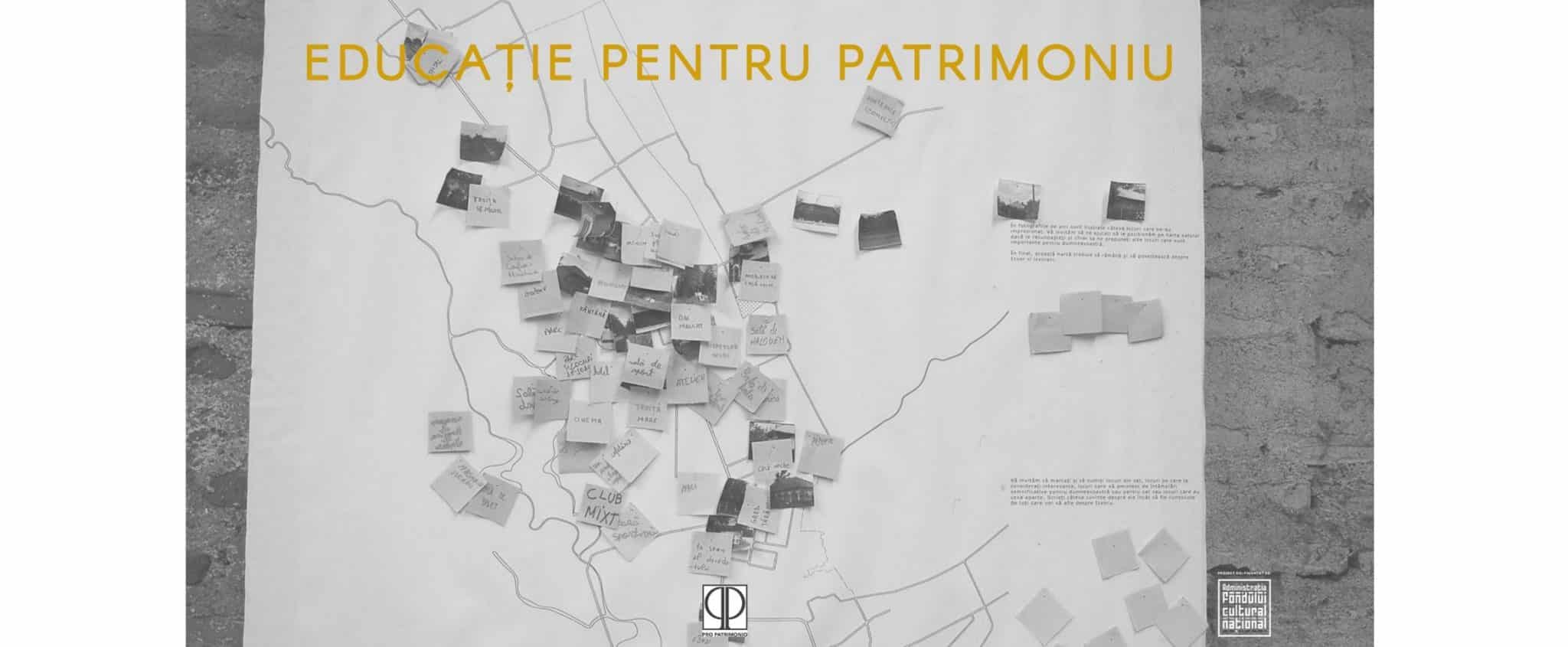
The Project “Education for Heritage” in 2019
Following its mission to conserve, rescue and reactivate the cultural heritage, especially in the realm of architecture, in Romania, Pro Patrimonio Foundation focuses on practical projects for the protection and rehabilitation of heritage, , but also on the community involvement and identitary self-awareness, the memory and the value of cultural heritage.
Our projects for heritage education have focused from the beginning on the consolidation of a lasting relationship between a community and the cultural elements of value in its immediate vicinity through a more or less structured series of workshops and events dedicated to young audiences.
In the past three years, the children’s communities around the Neamțu Mansion in Olari, the Perticari-Davila Mansion in Izvoru and the Golescu Villa in Câmpulung-Muscel have benefited from constant activities that investigated the local material and immaterial heritage through games, models, practical workshops and crafts. Over 12 caravan workshops have thus been organized – Izvoru-Olari-Golescu – creating a habit within the respective communities.
The project “Education for Heritage” structures, transforms and enriches the meetings and workshops that occured so far in a heritage program that will be tested in these three communities, but is also dedicated and meant to be put into practice in any other community that wishes to encourage creative exploration of local cultural values and heritage by children.
The project aims to:
– making and implementing the program in 5 practical workshops that involve investigating the world of heritage through games and challenges about the jobs of heritage specialists and carrying out architectural projects (arranging their own play space, workshop, cinema or reading space) and gardening on a 1: 1 team scale, as well as celebrating the projects which ran over the year together with the whole community in a dedicated event;
– preparing a digital guide and a workbook for childrenaccessible online, which may be used in the future by other interested people or teachers eager to implement such a project in their own community;
– preparing of the support materials needed to support such workshops;
– creating a first set of objects, toys and gamesmechanisms for the promotion, development and growth of such post-project activities;
– Making short film for presenting and promoting the project that are accessible in the online environment.
We hope we can:
– enrich the existing educational offer through accessible educational programs addressed especially to disadvantaged or vulnerable communities where the cultural heritage is threatened;
– continue and encourage long-term initiatives of this kind both within the communities involved in the project, as well as in other communities;
– bring communities closer to the object and notion of heritage and to the foundation’s activities (both during and after the project) by using the spaces and equipment from the project for educational purposes, to care for the new gardens and even for personal initiatives;
– create a mechanism for workshop and event self-maintenance at the manors by donating to events and sales after the financing period of educational toys.
Cultural project co-financed by the Administration of the National Cultural Fund. The project does not necessarily represent the position of the Administration of the National Cultural Fund. AFCN is not responsible for the content of the project or how the results of the project can be used. These are entirely the responsibility of the beneficiary of the financing.
Tablou activitati The Project “Education for Heritage” in 2019

